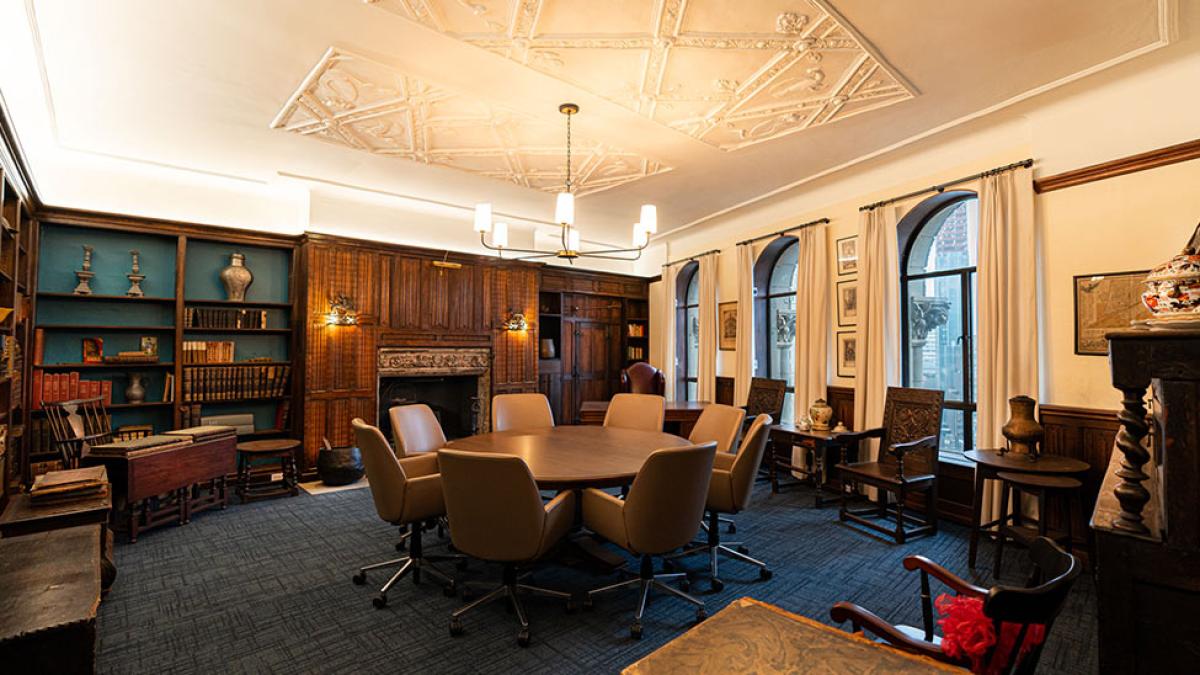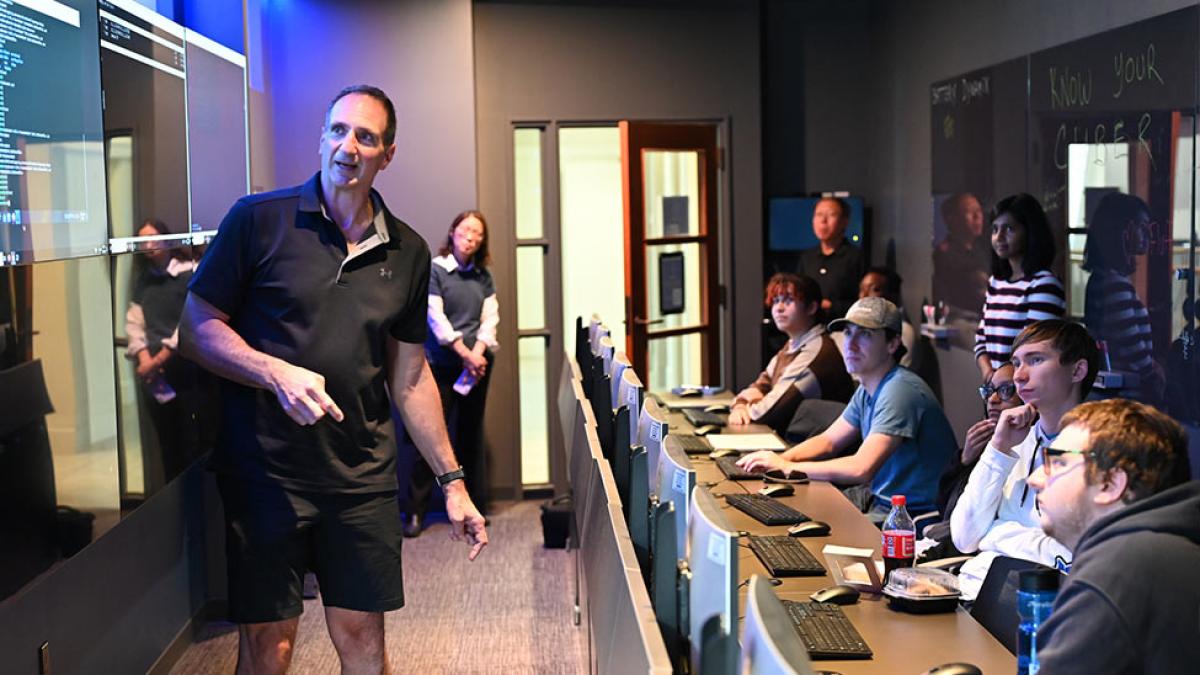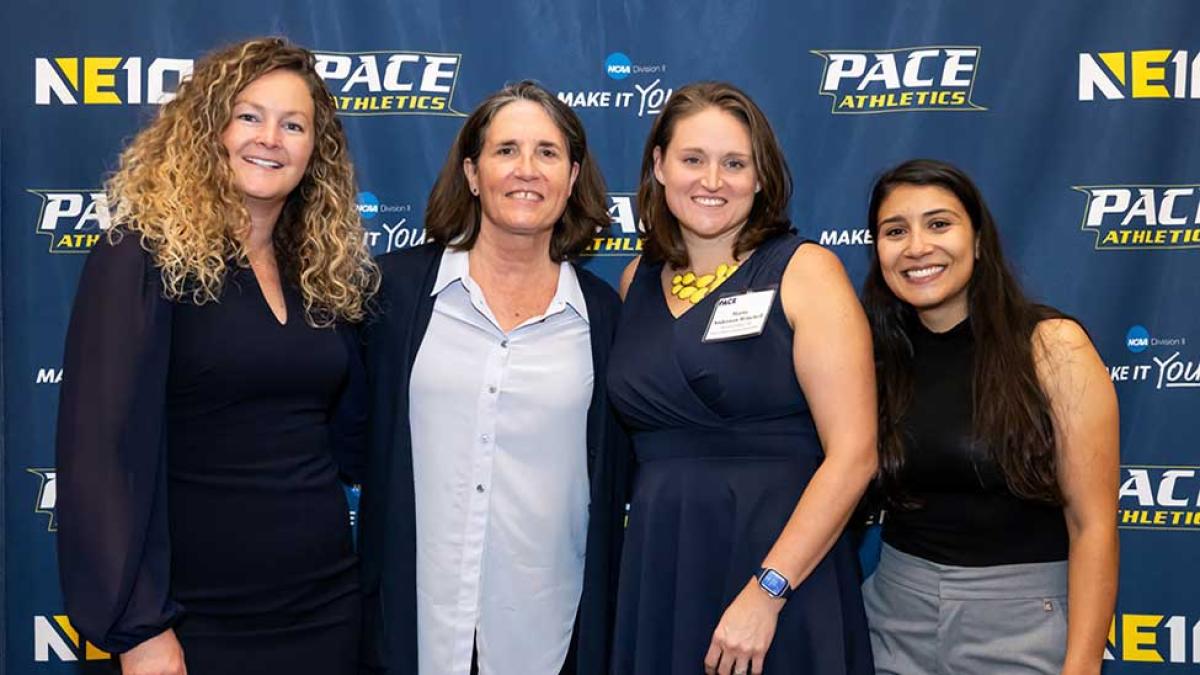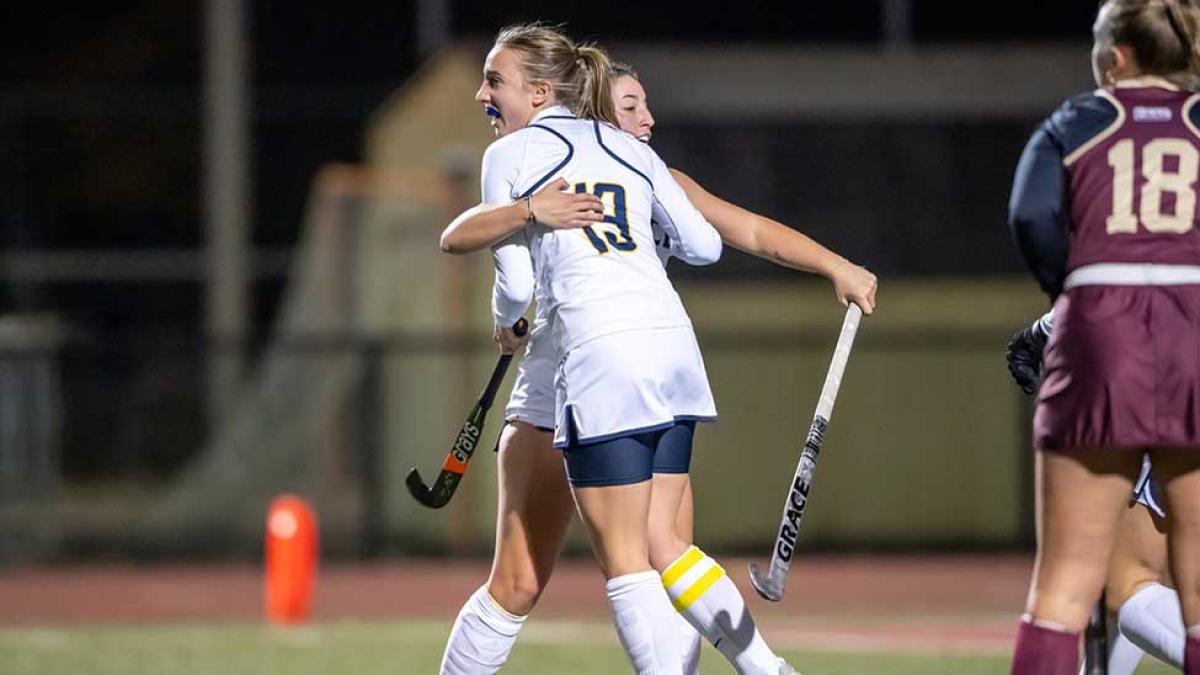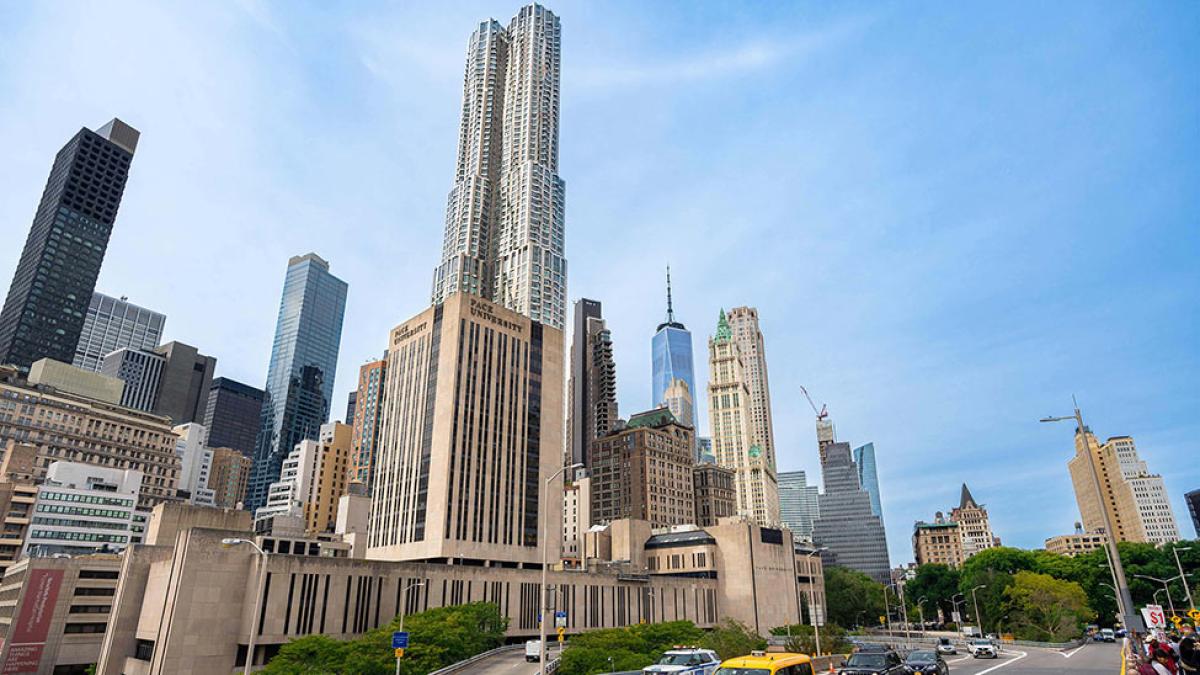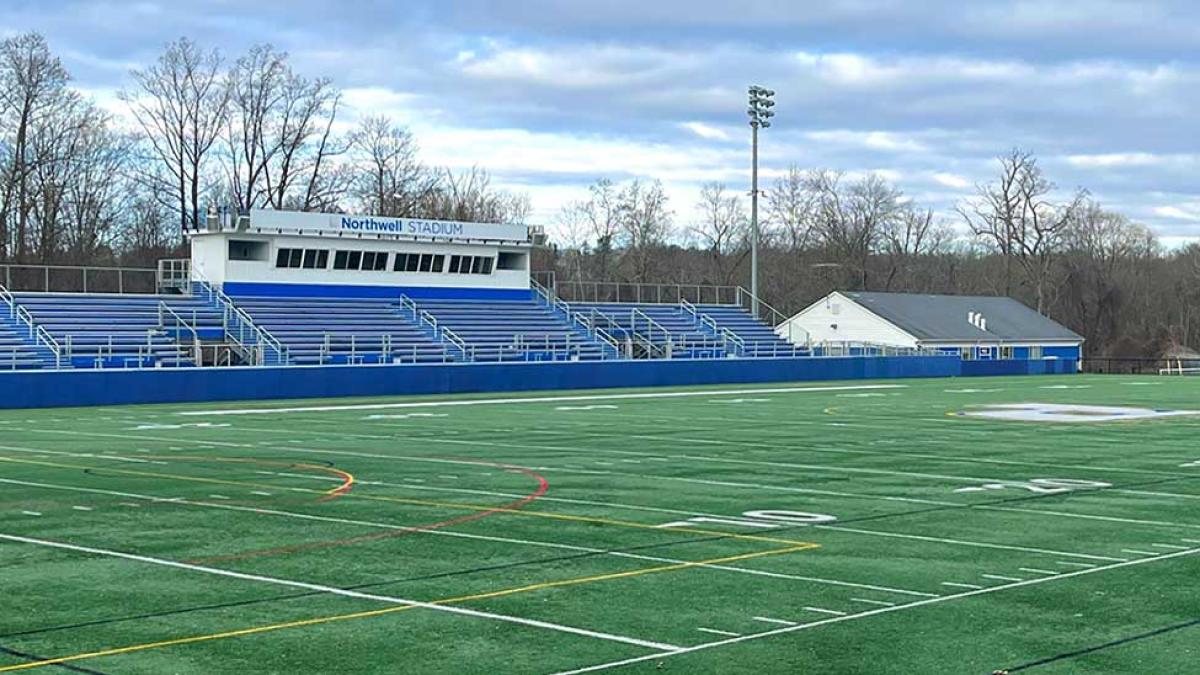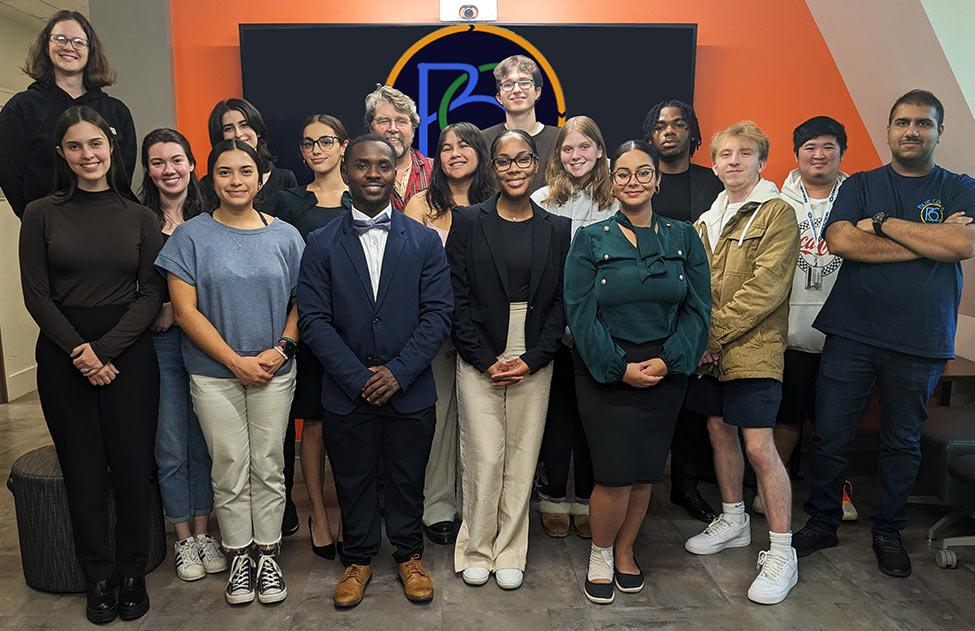
Learning Beyond Limits
Experiential learning isn't just a trend in higher education; it's the heartbeat of the Pace experience. From donning hip-waders to assess water quality, documenting first-hand narratives of a groundbreaking era in human history, immersing in a transformative semester in LA, to initiating and overseeing on-campus businesses from inception—Pace students don't just learn, they do.
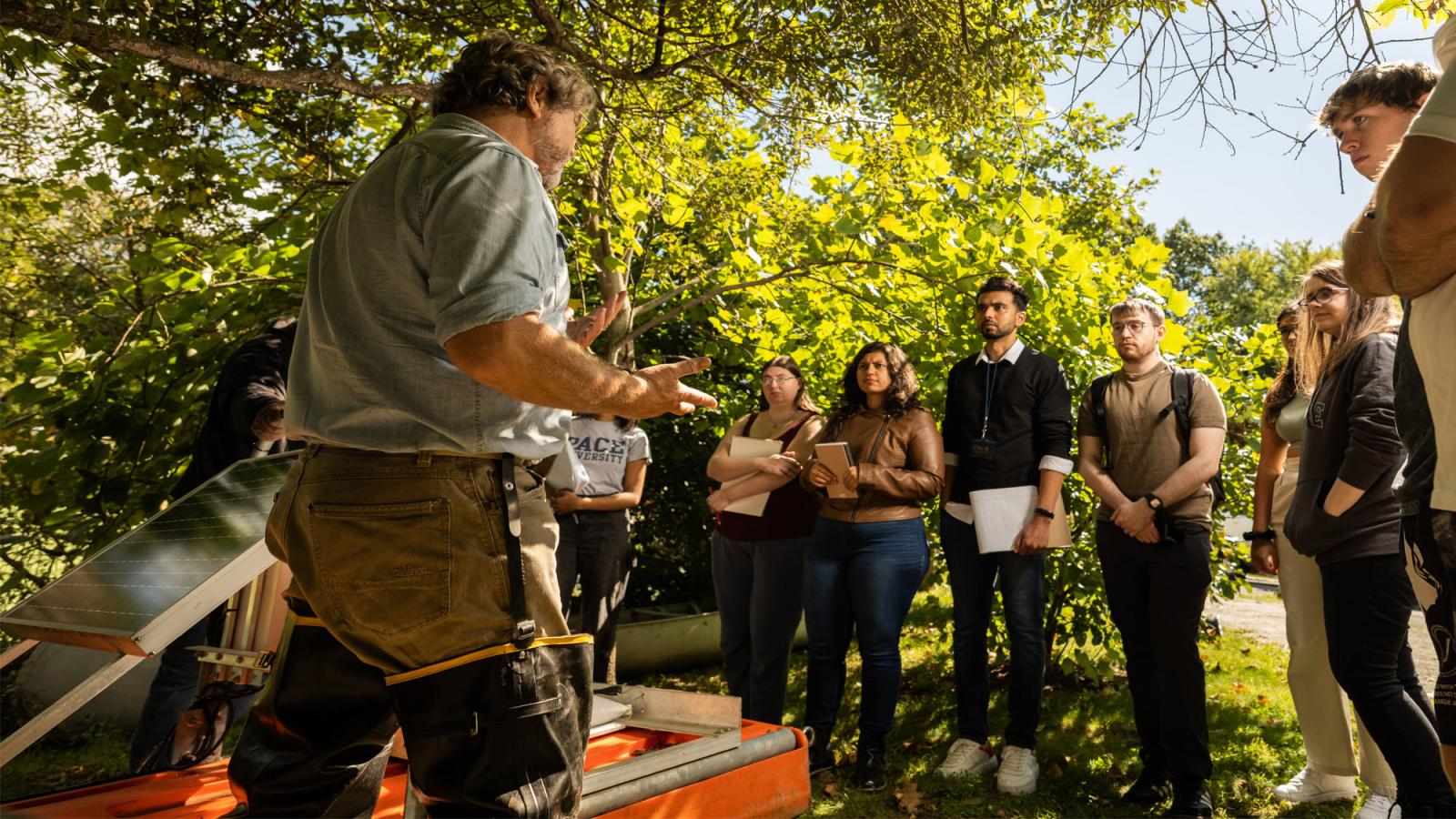
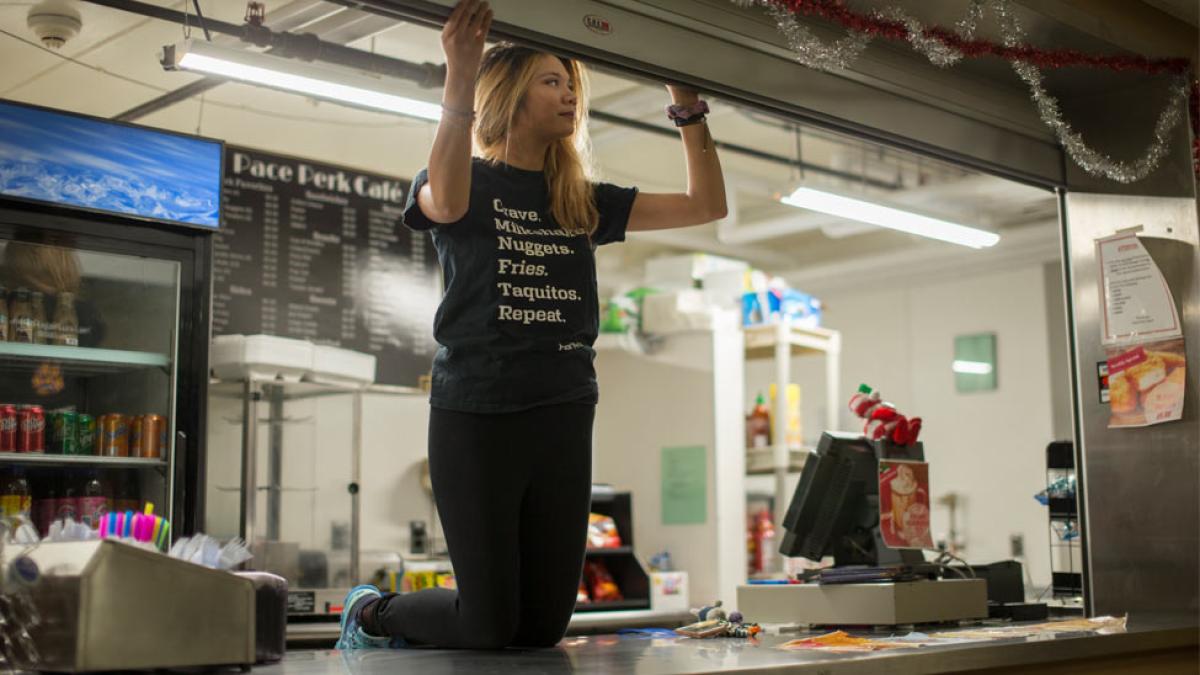
In recent years, there’s been a significant increase of focus on experiential learning in higher education, and for good reason. When it’s done well, experiential learning goes beyond preparing students for internships and full-time jobs. Students who have the opportunity to do their own research, make creative decisions, and take control of their learning are more likely to feel confident in shaping the world that they wish to see and live in. At Pace University, students across the University have opportunities to engage in experiential learning from their first year through graduation. This is the Pace difference—where learning is not a spectator sport but an exhilarating adventure that shapes resilient, adept leaders.
Director of Experiential Learning and the Pace Path Kelley Kreitz, PhD, supports and builds experiential learning opportunities—a key priority for Pace—within the University. “Pace has experiential learning opportunities running throughout our schools and liberal arts core curriculum,” Kreitz says, “Which allows students to participate in classroom-based research and civic engagement projects from their first day."
These opportunities help students build up their resumes before graduation, as well as support a widening of interests, exposure to new ideas, professional paths, and prospects that shape college experiences and ultimately lead to a fulfilling career.
Experiential Learning Across the Colleges
The strategic plan for experiential learning at Pace explains that “experiential learning is at the core of what we do. It encompasses learning both in and outside of our classrooms and involves students in original research, community engagement, internships, clinical placements, practical learning, problem solving, and building their professional skills.” Each college and school within the University offers unique chances for students to engage in their field of study, whether in class or in the community.
At the Seidenberg School of Computer Science and Information Systems, students can join the Blue CoLab team of interns, faculty, and staff to develop systems that protect humans and environmental health from water contamination. Within the Dyson College of Arts and Sciences, students can enroll in a course that provides them with the background and skills to collect oral history interviews covering COVID-19 and Black Lives Matter. Within the newly formed Sands College for Performing Arts, commercial dance majors travel to Los Angeles for a semester to practice directing, producing, acting, and dancing in their own shows. At the Lubin School of Business, students can gain hands-on managerial experience working with one of the five student-run businesses through the Center for Student Enterprise.
At Pace, “experiential learning” isn’t just the phrase du jour—it’s who we are. It’s who we’ve always been.
Blue CoLab: Right to Know What’s in Our Water
“We don’t know what’s in that glass before we drink,” Professor John Cronin, director of Seidenberg School’s Blue CoLab says. “I have a right to know what’s in my water.” And he would know. Cronin is known internationally for his 17 years as Hudson Riverkeeper and was named a Time magazine Hero for the Planet for his work fighting river pollution. At Pace, Cronin has been pioneering experiential learning for more than 20 years. He’s no stranger to inspiring student advocacy, as co-instructor for the Environmental Policy and Animal Advocacy clinics, coordinator of the annual Mock Legislative Hearing Competition, and even having co-founded Haub Law’s Environmental Litigation Clinic.
That’s the foundation of Blue CoLab, a project providing hands-on experiences in technological monitoring of water quality. With a strong commitment to the principle that there’s a human right to clean water, which requires the right-to-know that the water is clean, the program involves training, innovation, and research in real-time water monitoring technology.

More than two billion people will be threatened by unsafe water this year, which can lead to waterborne illnesses and other negative health outcomes. While many Americans see unclean water as an issue only in underdeveloped countries, the impact is local as well. This is demonstrated by the long-lasting impact to Parkersburg, West Virginia, caused by chemical dumping by Dupont and the lead contamination of drinking water in Flint, Michigan. In addition, 19.5 million illnesses are caused by pathogens in water in the US annually.
Cronin, Professor Leanne Keeley (who is Blue CoLab’s technical operations director), and a team of dedicated students work on the Pleasantville Campus tracking the health of Choate Pond, which eventually drains to the Hudson River. Meryl Mizell ’25, computer science major and Right-to-Know H20 team coordinator, explains the process, “In our pond, we have water quality sensors that monitor the water quality. We’re able to use that tech to pull data from the pond to allow people to see what the pond water quality is in real-time.”
The solar-powered water quality monitoring stations, lovingly named Ada and Alan (after 19th century mathematician Ada Lovelace, and British computer scientist Alan Turing, who broke the Nazi Enigma code) take measurements every fifteen minutes and send that data to a Seidenberg server. The team then uses that data to evaluate the water quality, create apps, products, and presentations that help deepen the public understanding of water. The pond serves as Blue CoLab’s “living laboratory,” complementing its data lab in Goldstein Academic Center and its tech lab off-campus.
“So overall, we do focus on the campus using the pond, but we want to implement it on a global scale,” says journalism major Lilah McCormack ’25. “The forefront of our idea is having the right to know what’s in the water we drink in real time. We do get water quality updates from local government agencies, but they only come after a year after you’ve used that water, so they’re not very useful in making healthy decisions.”
We have a really unique opportunity here at Pace, and I think that comes from our mentorship. What we’re doing here is really special.
Students work closely with Professor Cronin, who has been working on environmental issues for over 50 years. Lilah attributes the success of the Blue CoLab program and experience she is gaining to the mentorship and knowledge shared by Professor Cronin. “We have a really unique opportunity here at Pace, and I think that comes from our mentorship. What we’re doing here is really special. Sure, there’s a lot of initiatives towards ending the global water crisis, but nobody’s thinking about the technological advances that can make it possible.”
Recently, the six students who work on Blue CoLab’s Right-to-Know H20 project were accepted into the 2023 class of the United Nations Academic Impact and Millennium Campus Network Fellowship Program. The semester-long program gives students the opportunity to lead projects that advance the UN’s Sustainable Development Goals. The students working as part of the Right-to-Know H20 team are not merely advocates in civic engagement, but an active force striving to fulfill the United Nations’ Sustainable Development Goal, recognizing water as fundamental to all aspects of life. To aid the mission, the Right-to-Know H2O Team has petitioned the United Nations Secretary General António Guterres requesting the UN to declare the right-to-know water quality a fundamental human right.
The ability for these students from across the University to engage with experiential learning that revolves around critical scientific work helps to shape their college experiences, what they hope to do in their careers, and the way the world interacts with water.
“The work that we're doing here at Pace University is just the beginning of what’s possible,” concludes Sasha Palmer ’25.
The Oral History of COVID-19 and Black Lives Matter
The COVID-19 pandemic and the Black Lives Matter movement during 2020 forever shaped communities around our nation. Capturing first-hand experiences of how these events impacted people is a critical part of providing primary sources for future researchers, and that’s what Assistant Provost and Clinical Associate Professor of History Maria Iacullo-Bird, PhD, set out to achieve with her Oral History Project.
“Interviews provide a way to center personal human experiences during major historical events,” Iacullo-Bird says, “which become even more important as times of crisis and momentous change recede into history. I am excited that Pace undergraduates have generated primary sources to provide first-hand knowledge about watershed historical events.”
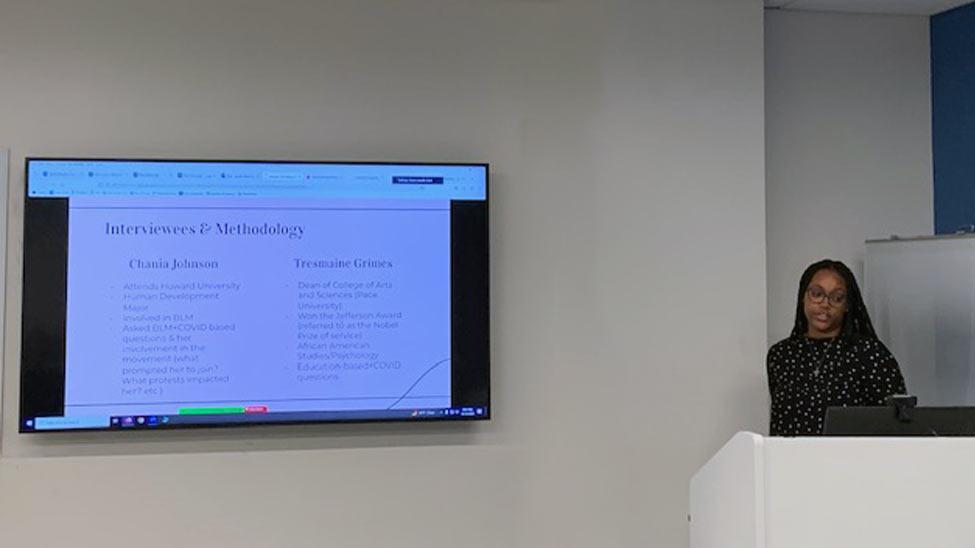
The project was developed as part of Iacullo-Bird’s Honors history course, HIS 196H: COVID-19 and Black Lives Matter: Comparative, Crisis-Based Oral History in the American Experience. The course is designed as a Course-Based Undergraduate Research Experience (CURE), which gives students training as oral historians to conduct research. Iacullo-Bird explains that this course in particular “explores the intersectionality between disease and social justice struggles.”
After students gain an understanding of the importance of oral history and develop close listening skills, students are tasked with selecting interview subjects and preparing questions that capture their interviewees’ unique experiences. Recent interviews are stored online on the Oral History webpage as a resource for other students and researchers.

“The interviews I conducted were great experiences,” says film and screen studies major Carter Haskins ’24. He explored the intersectionality between race and the long-term health impacts caused by COVID. “I found that the conversation came naturally. I ended up going to interviews with a prepared list of questions but not using them, and the outcome was fantastic.”
I feel like I will be able to engage in more meaningful research now that I understand the importance of considering how a historical event affects those experiencing it.
Jillian Igneri ’26, added, “During the early stages of my interview preparation, I was excited by the prospect of exploring aspects of recent crises, namely the COVID pandemic and the matters of racial injustice throughout 2020, that I had not experienced through my own eyes as they occurred.” This led Jillian to explore how educators dealt with the disruptions to learning caused by the pandemic as well as how educators’ roles in helping students grapple with social change evolved.

“Oral history has allowed me, as a history major, to engage with my community outside of the traditional academic space,” shared Natalie Filkins ’25, who focused her research on the impact COVID had on the unhoused population of New York City. “I feel like I will be able to engage in more meaningful research now that I understand the importance of considering how a historical event affects those experiencing it.” She adds, “As a historian, I found this project to be incredibly engaging, requiring me to exercise skills I haven’t used in other history courses.”
Na’Mya Sinclair ’26, a nursing student, who researched the Black Lives Matter movement and the function of higher education learning experiences for people of color, plans to continue studying nursing. However, she shares that “this project has significantly informed how I aspire to participate in the Pace University, New York City, and global communities. I am inspired to actively participate in discussions and initiatives that address racial inequalities, particularly within the university setting.”
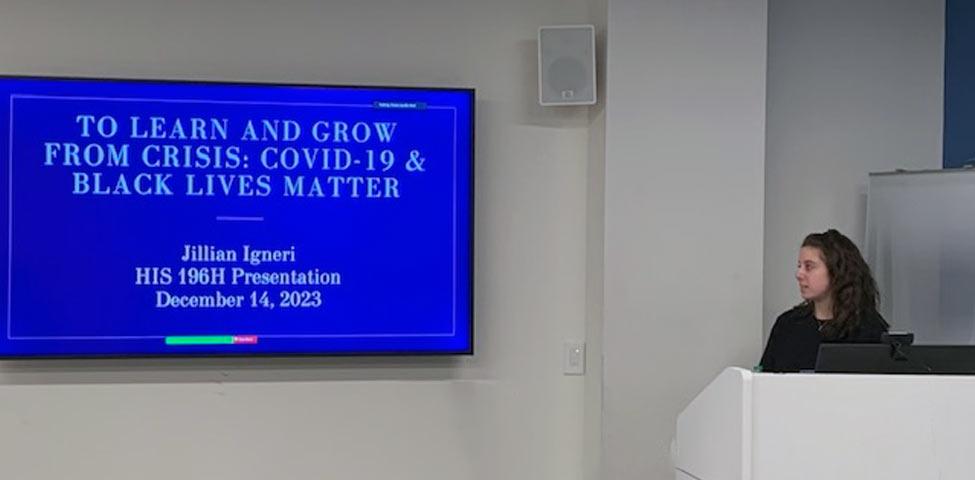
Iacullo-Bird hopes that students will “deepen their understanding of how to be engaged citizens and problem-solvers in community-building projects.” The skills they develop through the research-based course also enable students to clarify career goals and apply what they have learned both in their studies and the workplace.
A Semester in Los Angeles for Commercial Dance
“I remember telling the class of 2026, LA is the best semester. Just wait until you get to LA, you’re going to have the time of your life,” says commercial dance alumni Tiffani Russell ’23. She adds, “The previous statements were understatements.”
The goal of the commercial dance program is to prepare students to navigate the entertainment industry—across Broadway, concerts, TV, film, and working with music artists—as a dancer. Program head Rhonda Miller wants to set students up to be “completely prepared” to be comfortable with any style of dance, have the tools to book work, manage, and sustain longevity in their long-term careers.
Spending a semester in LA gives Pace students the chance to acquire and practice these skills. While dancers hone their skills in ballet and jazz in California, they’re also learning how to dance for the camera. “Dancing on camera is very different from dancing on stage,” explains Miller.
Tiffani says that the classes “advised us to think outside of our physical talents.” Students are challenged by industry professionals to learn about the variety of roles required to create movies, TV shows, concerts, Broadway performances, and music videos. The master teachers, who are active industry professionals, visit the students multiple times throughout the semester and provide information on the additional roles available in the industry beyond just dance.
Jillian Meyers, well known for working with Evolution Dance Company and Janet Jackson, is a regular instructor during the semester. Tiffani shares that Meyers taught about “the roles outside of dance that make up the industry, types of cameras, and how to choreograph for the camera. For a commercial dancer, exposure to these working professionals in an educational setting is unheard of.”
Students also have the opportunity to connect with agents, who act as a dancers’ representation and facilitate auditions. Working with bi-coastal agencies sets students up to find work in Los Angeles and New York City. Miller brings agencies to the students throughout the semester, giving agents time to watch the students dance in a private setting. As a follow up to that initial introduction, students prepare a showcase for the end of the semester, where dance agents, choreographers in the industry, and directors will be in attendance.
The stress of getting an agent is off the table. I feel very proud of that because a lot of people move to LA or New York, and they have to go to these huge calls to try to get an agent. Whereas I’m bringing the agencies directly to the students.
“Our showcase is exciting because some performances are done live in front of the agents, choreographers, and directors,” says Miller. “And then we also show a great deal of work done on film. Different projects that the dancers have done during the semester are shown so that agencies can see dancers in two different realms and decide someone is really great.”
Miller estimates that 70 to 75 percent of her students are agented by the end of their third year in the program, following the semester in LA. “The stress of getting an agent is off the table,” Miller says, adding, “I feel very proud of that because a lot of people move to LA or New York, and they have to go to these huge calls to try to get an agent. Whereas I’m bringing the agencies directly to the students.”
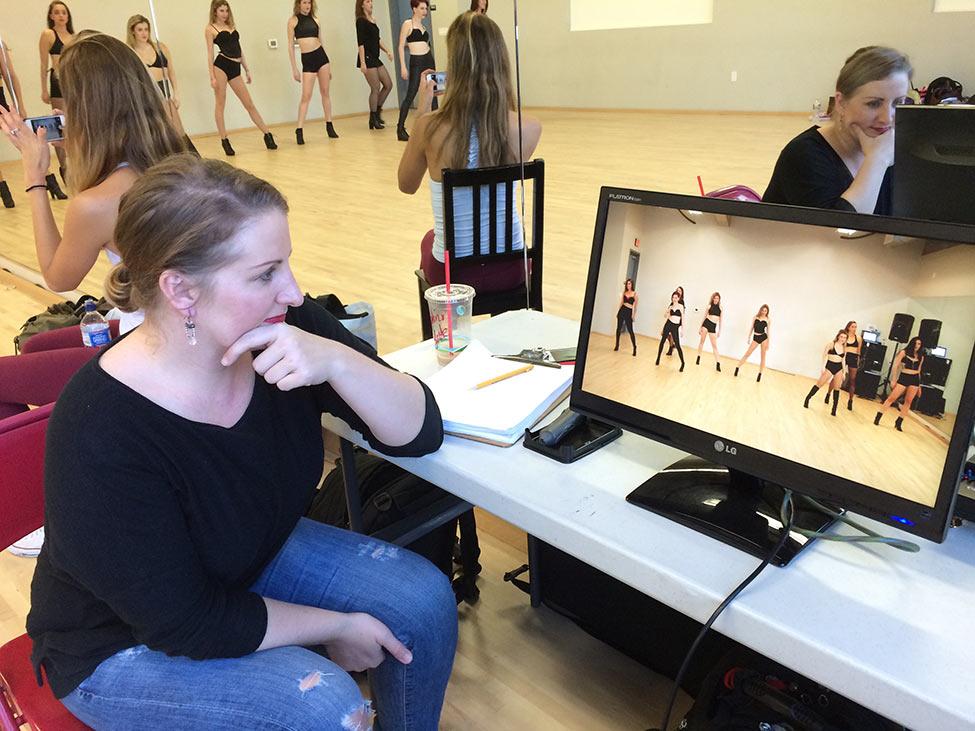
Students in the commercial dance program often work short gigs, like commercials, during their senior year, which is something the program is structured to accommodate. After graduation, students find success working with TV, film, and dancing with musical artists. “We had a lot of students that did the Video Music Awards last year in New York,” says Miller. “One alumna, Briana Pavon, is performing with Beyoncé now. At least two of our alumni received callbacks for tour auditions with Olivia Rodrigo, which just happened the week of January 8.”
Tiffani, who has gone on to work with Doja Cat at the 2023 VMAs, shared, “I have always dreamed of dancing behind an artist, seeing myself on my TV, or getting to perform live in front of an arena full of people. With the LA semester under my belt, those dreams were made possible.”
Managerial Experience with the Center for Student Enterprise
At the Center for Student Enterprise (CSE) within the Lubin School of Business, Pace students are doing more than just studying business—they’re running it. On the Pleasantville Campus, five student-run businesses provide real-world opportunities to over 65 students, who are gaining hands-on experience in management, marketing, finance, and operations.
These enterprises—Pace Mart, Pace Fit, Pace Delivers, Pace Perk, and Setters Stage—offer students a chance to go beyond the classroom and into the boardroom. Whether it’s sourcing inventory, analyzing financial statements, or managing social media campaigns, students are developing a toolkit of skills that set them apart.
“My experience working for Pace Mart has been truly a blessing,” says Pace Mart Senior Marketing Manager and Lubin BBA student Joseph Ingles ’25. “My hard skills and soft skills have enhanced greatly. Running a business like Pace Mart, sometimes things come up out of nowhere and you just have to adapt to the situation at hand. That experience has made me stronger and prepared for what is to come.”
Maggie Glynn is another student who can testify to how working at a student-run business has impacted her experience at Pace. Maggie ‘26, Public Accounting BBA and MBA, is the Chief Financial Officer of Pace Fit, the healthy snack bar located in Goldstein Fitness Center. “I have gained so much real-world experience from the CSE,” Maggie says. “I was drawn to Pace for the internship opportunities, but little did I know I would gain a deeper understanding of the workforce and what I want my role to be from working on campus. Working at Pace Fit allowed me to get real-world accounting experience as a sophomore. I learned what I love about the profession and where I can see myself continuing after graduating.”
She adds that she has gained invaluable technical and soft skills between managing a team, problem solving, and handling finances, “I learned how to prepare, analyze, and present financial statements for board meetings. I learned the value of communication, compromise, and leadership.” Maggie insists, “This continues to be a skill that sets me apart from other candidates when interviewing for accounting internships.”
All of the student managers tell me that when they go for interviews for internships or full-time jobs that all the interviewer wants to ask them about is their position at the student-run business.
Kathryn Winsted, PhD, is the director of the Center for Student Enterprise. She has a deep understanding of how experiential learning enhances what students do in the classroom and helps them discover what really matters in the world of business. Winsted has acted as the advisor to all five of the student-run businesses since they first opened in 2010, and has helped students succeed through different challenges, including COVID-19. Throughout the years, she has seen students thrive in their roles and launch into careers they feel passionate about.
“All of the student managers tell me that when they go for interviews for internships or full-time jobs that all the interviewer wants to ask them about is their position at the student-run business,” Winsted said. “My favorite story is when the student who was one of the original founders of Pace Mart went for an interview at J.P. Morgan, she was able to answer the situational questions with real experiences she had at the business she was running. She was hired on the spot.”
Beyond seeing students find success in their careers, Winsted knows that the students “learn so much more in their courses when they use it in running the businesses and bring that practical experience to their learning.” She hopes that they learn beyond classroom concepts as well, saying that there are many opportunities to practice handling conflict and problem solving, aiding them in becoming adaptable and finding self-motivation.
For students looking to maximize their time at Pace, the Center for Student Enterprise offers more than employment—it offers transformation. Just ask any of the students who’ve managed a budget, supervised a team, or pitched an idea—and walked away with the confidence to lead.
The Future of Experiential Learning at Pace
For Pace University, experiential learning isn’t just a flash in the pan and it’s certainly not a response to trending topics in higher-ed forums. The plans for hands-on learning will continue to include working on building even more first-year experiences, providing opportunities for students from across majors to work together, and eventually collaborative spaces to work on projects.
My overarching goal is to achieve a sense of identity, community, and pride in our approach. I want to realize our potential to be a nationally recognized model of an experiential future of higher education.
Kelley Kreitz knows that the University will continue to adapt. “Classrooms at all kinds of educational institutions have historically provided a one-way flow of information from the professor-as-expert to the student-as-learner,” she says, adding, “My overarching goal is to achieve a sense of identity, community, and pride in our approach. I want to realize our potential to be a nationally recognized model of an experiential future of higher education.”
More from Pace Magazine
Nestled in a corner of the 16th floor of the iconic 41 Park Row, a building steeped in history, the Pace Study is a hidden gem. Within its walls, the Study served as the workspace for Robert S. Pace, the second president of Pace University and son of co-founder Homer Pace. Nowadays, it's a haven for small, but significant University meetings.
When his wife Kimmi Stephens suddenly had a seizure, Tim Myers, a scientist studying epilepsy, felt his field of study abruptly collide with reality. This shocking moment sent the pair of Pace professors on a winding journey of recovery, resilience, and research, and ultimately to the creation of a new lab on the Pleasantville Campus.
Meet Cyber Range: Pace’s new, state-of-the-art facility designed to give students a collaborative, practical immersion in tackling real-life cybersecurity threats, all in real-time.
#PaceGoGetters: Ka’ramuu Kush
Kush joined the Sands College of Performing Arts Faculty in Fall 2022, and has hit the ground running. He's bringing his experience as a multi-hyphenate artist into the classroom to empower the next generation of performing artists.
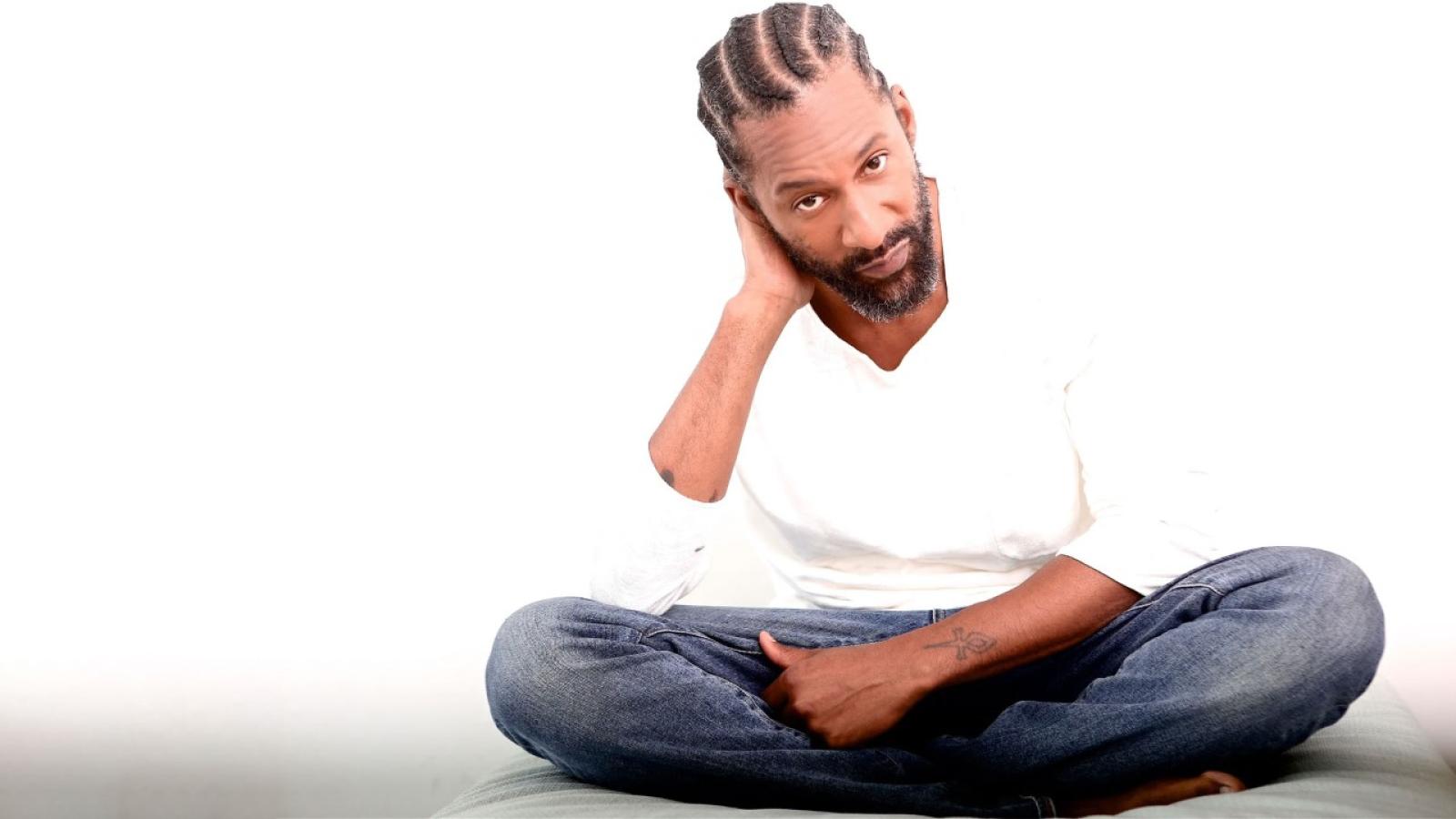
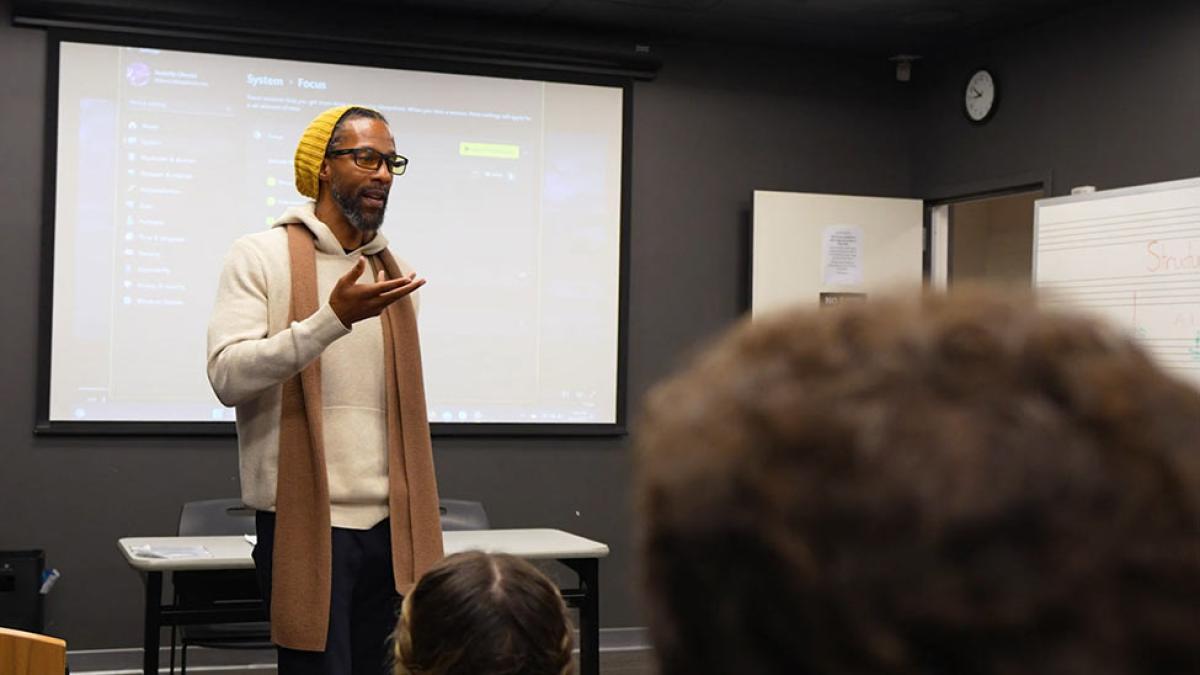
When Ka'ramuu Kush joined the Sands College of Performing Arts Faculty in Fall 2022, he was determined to bring a wealth of knowledge to the next generation of performing artists. Not only is he bringing a wealth of theory and artistic knowledge, he wants to empower his students with practical, actionable lessons that will help them succeed in the entertainment business.
More from Pace Magazine
Pace’s First Generation Program is dedicated to uplifting and supporting first-gen students who are often left to chart their own course. Read on for student perspectives on the unique challenges and experiences these students face.
Pace clinched the title of Westchester's best. Our Broadway spotlight is shining. Carbon emissions? We're slashing them. We've introduced a new initiative for hidden disability awareness. Oh, and did we mention our sleek new building in NYC? All this and more in 10 Things to Inspire You!
Nestled in a corner of the 16th floor of the iconic 41 Park Row, a building steeped in history, the Pace Study is a hidden gem. Within its walls, the Study served as the workspace for Robert S. Pace, the second president of Pace University and son of co-founder Homer Pace. Nowadays, it's a haven for small, but significant University meetings.
Katina Hill-Thompson '00: Making History in Service of Others
From Pace University to a historic PhD, alumna Katina Hill-Thompson ’00 has never wavered from her dedication to others. Read her story, where her call to make a difference has led her on a journey defined by barrier-breaking achievements, dedicated social work, and a fierce determination to transform lives.
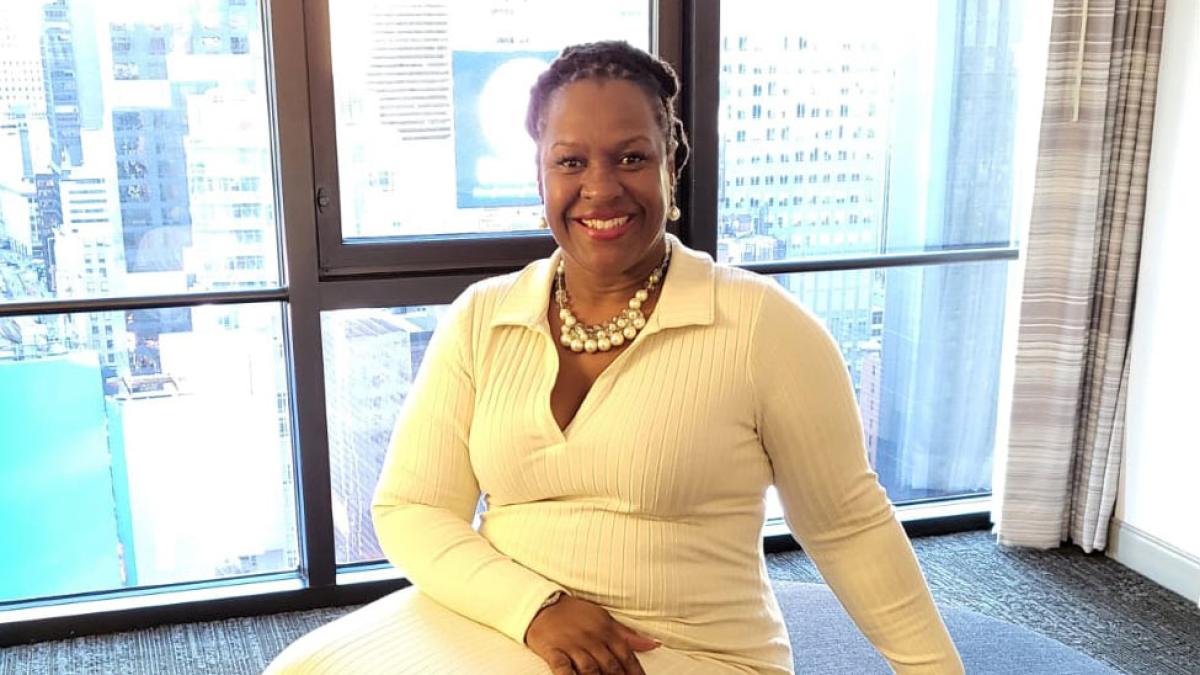
In a life defined by devoted service and compassion for others, Dyson College of Arts and Sciences alumna Katina Hill-Thompson ’00, PhD, LCSW, DSW, QS, has still found the time to make history through her own personal achievements.
Over more than 20 years, Hill-Thompson has forged a career founded on a higher calling—a passion for uplifting and inspiring others through social work and mental health counseling. All the while, she has recognized the value of continued education and professional growth in expanding her personal mission of service. To help others, she would need to invest in herself. And if that meant breaking down barriers and doing something that has never been done before, then so be it.
Because sometimes, that’s exactly what it takes.
In 2023, Hill-Thompson became the first-ever African American to graduate with a Doctor of Social Work from Florida Atlantic University. It was a landmark moment that cemented her legacy as a pioneer at the university and a trailblazer in her profession. But for Hill-Thompson, it was never about the recognition. In fact, she was already well into her doctoral studies when she first learned that her graduation would mark a historic first.
“I was floored when they first notified me,” Hill-Thompson said. “It was even more of a reason for me to continue moving forward no matter what battles I would face. I wanted to kick down the door to let others come through.”
"I wanted to kick down the door to let others come through.”
As a Pace University undergraduate, Hill-Thompson knew she wanted to dedicate herself to the health and wellbeing of others. It was something deeper than a career objective. It was a vocation, a sense of duty that she knew she would carry with her for the rest of her life.
When she enrolled in her first psychology class as an elective, she discovered a potential path for putting that calling into action. She found that she was fascinated by the human mind—the way it was shaped by its environment, the vast and endlessly compelling differences between individual people. She began to conceive of a way that she could help the vulnerable and marginalized with a holistic approach, taking into consideration not only their mental health, but their broader circumstances, the fullness of their stories and experiences.
She knew she wanted to marry her interest in psychology with her passion for care. But she credits a steadfast Pace mentor for helping her to take the next steps.
“Dr. Marie Werner was my mentor at Pace, and she continues to be my mentor to this day,” Hill-Thompson said. “She was the Black Student Union faculty advisor, and she solidified everything for me. I wanted to emulate her, be just like her. She helped me every step of the way, at each stage of my growth. She saw far more in me than I saw in myself. Our relationship remains strong, and I tell her all the time that she is the reason that I am who I am today.”
After graduating from Pace, Hill-Thompson attended Barry University in South Florida and earned a master’s degree in social work, a field at the convergence of her interests in human psychology and structural inequalities. Since then, she has assumed leadership positions at several social work organizations throughout her South Florida community, working in clinical and managerial capacities to provide counseling, care, and support to vulnerable patients, many of whom come from historically disadvantaged populations.
It is in her work with these groups, Hill-Thompson said, where she has seen her call to make a difference come most meaningfully to life.
“I’ve always been drawn to people who were disenfranchised and marginalized, because I am someone who comes from those populations,” she said. “Mental health was my calling, but social work allowed me to work with patients and understand their full experiences. I have a passion for showing them that no matter their background, they can achieve fulfillment in their lives. They can persevere. They don’t have to be a statistic. That’s what has driven me.”
That drive to empower others to rise above their circumstances—to become their best selves—is not merely a professional credo. It is a principle at the heart of Hill-Thompson’s worldview, a value that is central to her sense of self. This is evidenced by her partnership with her husband as longtime pastors at their church, where they provide counsel and spiritual ministration to a dedicated congregation.
As in her social work, Hill-Thompson’s spiritual leadership was born from an innate drive to help others overcome challenges and improve their lives.
“My faith has always been a part of keeping me strong and grounded, getting me through different difficulties,” she said. “I am very passionate about my work as a pastor. It’s something I will continue to do for the rest of my life.”
From Hill-Thompson’s time at Pace as a motivated undergraduate with big dreams, through her accomplished career, to her graduation as a doctor of social work—the first African American to earn that distinction in Florida Atlantic’s 63-year history—one thing has remained constant: an unwavering selflessness that inspires her to put the needs of others before her own.
Now, as a freshly minted PhD whose call to serve burns as bright as ever, Hill-Thompson has never been more motivated to continue harnessing her energy and experience to make the world a better place.
“Being the first African American to graduate with a doctoral degree in social work from FAU—I was shocked. I’m still shocked, but I know I have to keep going,” she said. “I want to show people that they can’t take no for an answer. That they’re stronger than they think they are, and that they have to fight for what they believe in. I am going to continue opening new doors for myself and creating new opportunities for others.”
More from Pace Magazine
Pace clinched the title of Westchester's best. Our Broadway spotlight is shining. Carbon emissions? We're slashing them. We've introduced a new initiative for hidden disability awareness. Oh, and did we mention our sleek new building in NYC? All this and more in 10 Things to Inspire You!
This fall was a landmark semester in terms of well-deserved accolades for a number of athletes and leaders who have been instrumental to the past success and continued excellence of Pace Athletics.
Pace’s First Generation Program is dedicated to uplifting and supporting first-gen students who are often left to chart their own course. Read on for student perspectives on the unique challenges and experiences these students face.
Breaking Records at the Job and Internship Fair
Record-breaking student turnout at the Fall Job and Internship Fair made it one of the largest job fairs in Pace history.
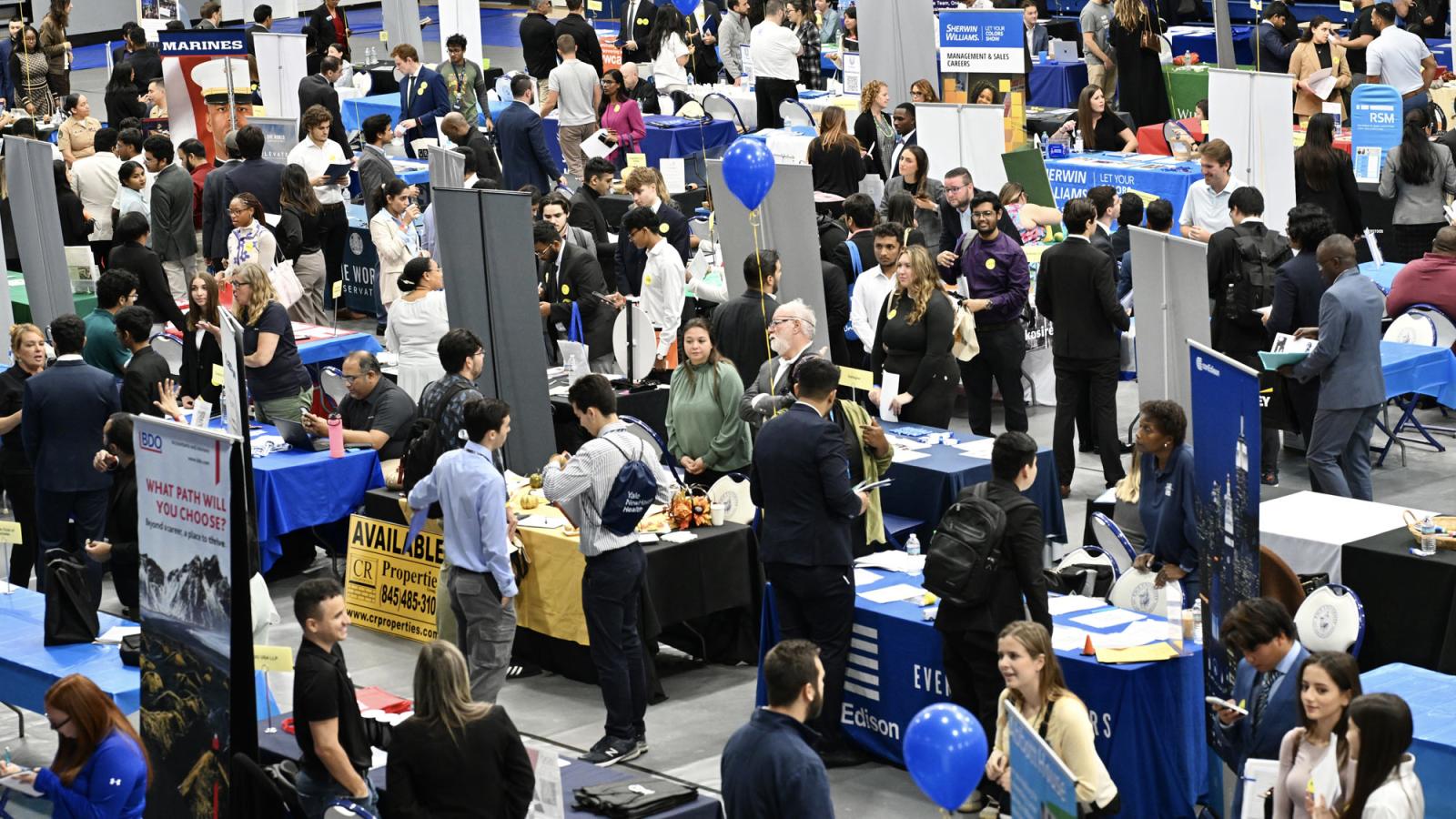
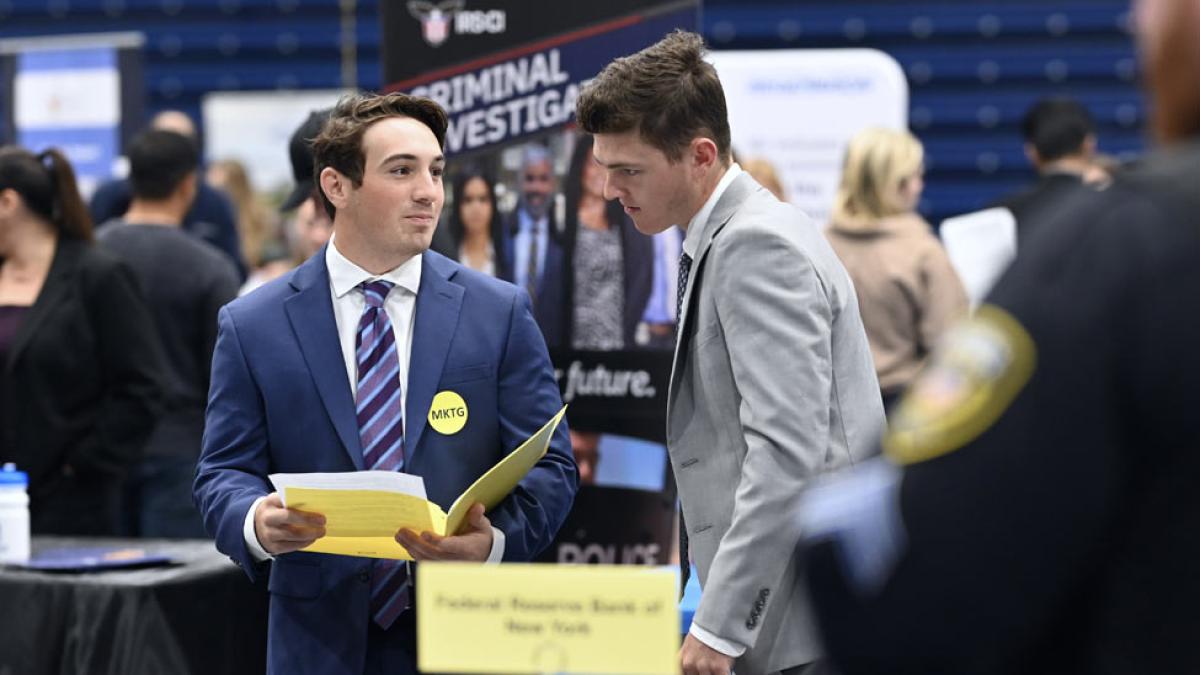
Approximately 800 students, including many from Pace’s New York City Campus, attended the employment fair, which boasted a lineup of over 115 companies, including big names like Northwell Health, Regeneron Pharmaceuticals, Sumitomo Mitsui Trust Bank, and Unilever. The atmosphere was lively, with employer-sponsored food and coffee trucks, smoothies from the University’s student-run businesses, and music, along with special amenities like a Quiet Room.
The fair, open to all majors, was sponsored by PricewaterhouseCoopers (PwC), one of the Big Four accounting firms. PwC offers a range of professional business services such as accounting, auditing, human resources consulting, and strategy management.
“It’s important to be exposed to different employers as this helps us navigate aligning our skills and interests to our future jobs.” —Rishitha Mandali '26
Phyllis Mooney, assistant vice president of Career Services, emphasized the Pace's commitment to early student engagement and impactful employer events. Mooney highlighted the goal of creating opportunities for students to secure great internships and jobs.
“At Pace, we understand the importance of engaging and preparing our students early, and creating impactful employer events that lead to great internships and jobs,” she says.
Pace’s Career Services is recognized regionally for providing comprehensive career counseling and programming to ensure that students are career-ready, able to confidently articulate the skills sought by employers in their industry. Over the last five years (2017–2021), Pace’s overall employment rate for bachelor and master graduates has consistently exceeded the national average by 10 percentage points, according to the National Association of Colleges and Employers (NACE) “First Destination Survey” report.
NACE’s latest Salary Survey report revealed positive outcomes for Pace's Class of 2022. Bachelor graduates earned full-time salaries $7,000 higher than the national average, with specific majors like registered nursing, communication, journalism, psychology, criminal justice and corrections, and finance reporting even higher earnings differentials. Master’s graduates in majors like education and accounting also outperformed national averages, with significant earnings differentials.
Pace’s Career Services doesn't just benefit students; it provides tailored, successful recruiting experiences for employer partners. This results in top brands, including Deloitte, EY, KPMG, Montefiore, New York-Presbyterian, Northwell Health, NYU Langone Health, and PwC, actively seeking out Pace graduates.
For Rishitha Mandali, a sophomore majoring in computer science, the packed room provided ample opportunities to land a job or an internship.
“It’s quite an advantage to have opportunities not only in New York City but also in Westchester,” said Mandali, who was among students from the lower Manhattan campus that attended the Job Fair. “It’s important to be exposed to different employers as this helps us navigate aligning our skills and interests to our future jobs.”
More from Pace Magazine
For the Nutrition and Dietetics Department within Pace’s College of Health Professions, the expansion of teaching kitchens means committing to a culture of wellbeing while educating future Registered Dietitians.
When his wife Kimmi Stephens suddenly had a seizure, Tim Myers, a scientist studying epilepsy, felt his field of study abruptly collide with reality. This shocking moment sent the pair of Pace professors on a winding journey of recovery, resilience, and research, and ultimately to the creation of a new lab on the Pleasantville Campus.
Pace clinched the title of Westchester's best. Our Broadway spotlight is shining. Carbon emissions? We're slashing them. We've introduced a new initiative for hidden disability awareness. Oh, and did we mention our sleek new building in NYC? All this and more in 10 Things to Inspire You!
Presidential India Trip Recap
At the end of October, President Marvin Krislov led a delegation of Pace University leaders on a ten-day trip through India to deepen the University’s connection with Indian alumni, strengthen vital collaborations across the country, and promote the extraordinary power of a Pace education to prospective students.
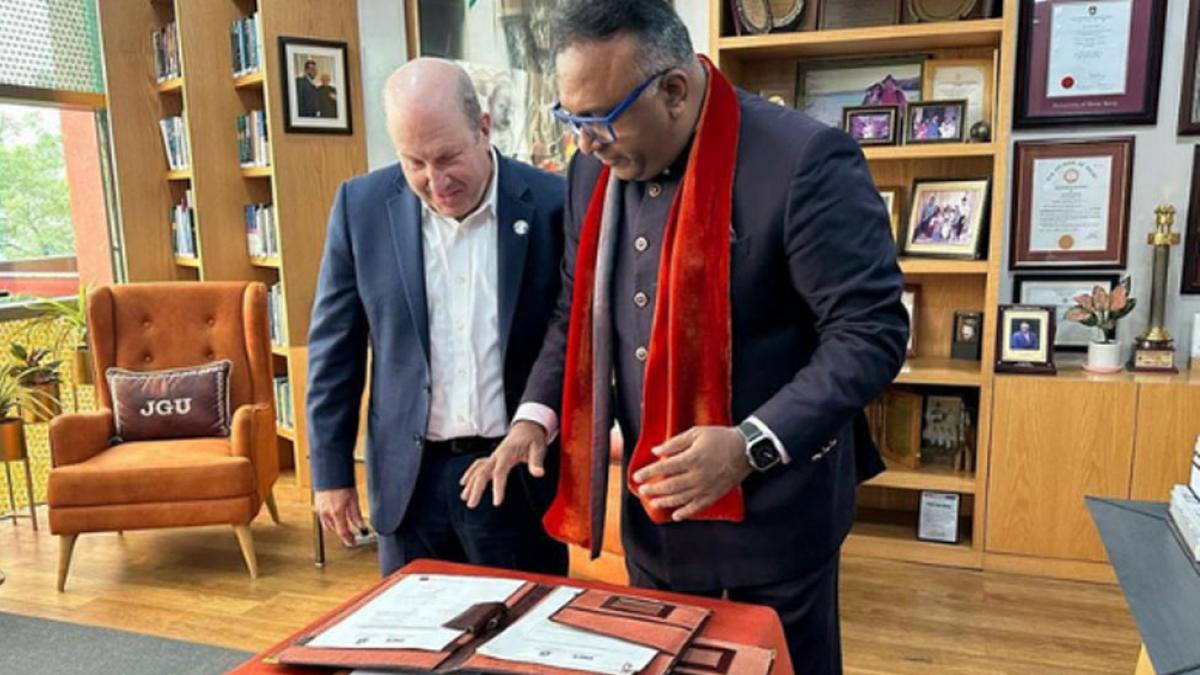
Winter 2024: Leadership Letter
At Pace University, we are embracing innovation and adapting to the evolving needs of our community. As we navigate through this dynamic era, our commitment to providing immersive and challenging learning experiences remains steadfast.
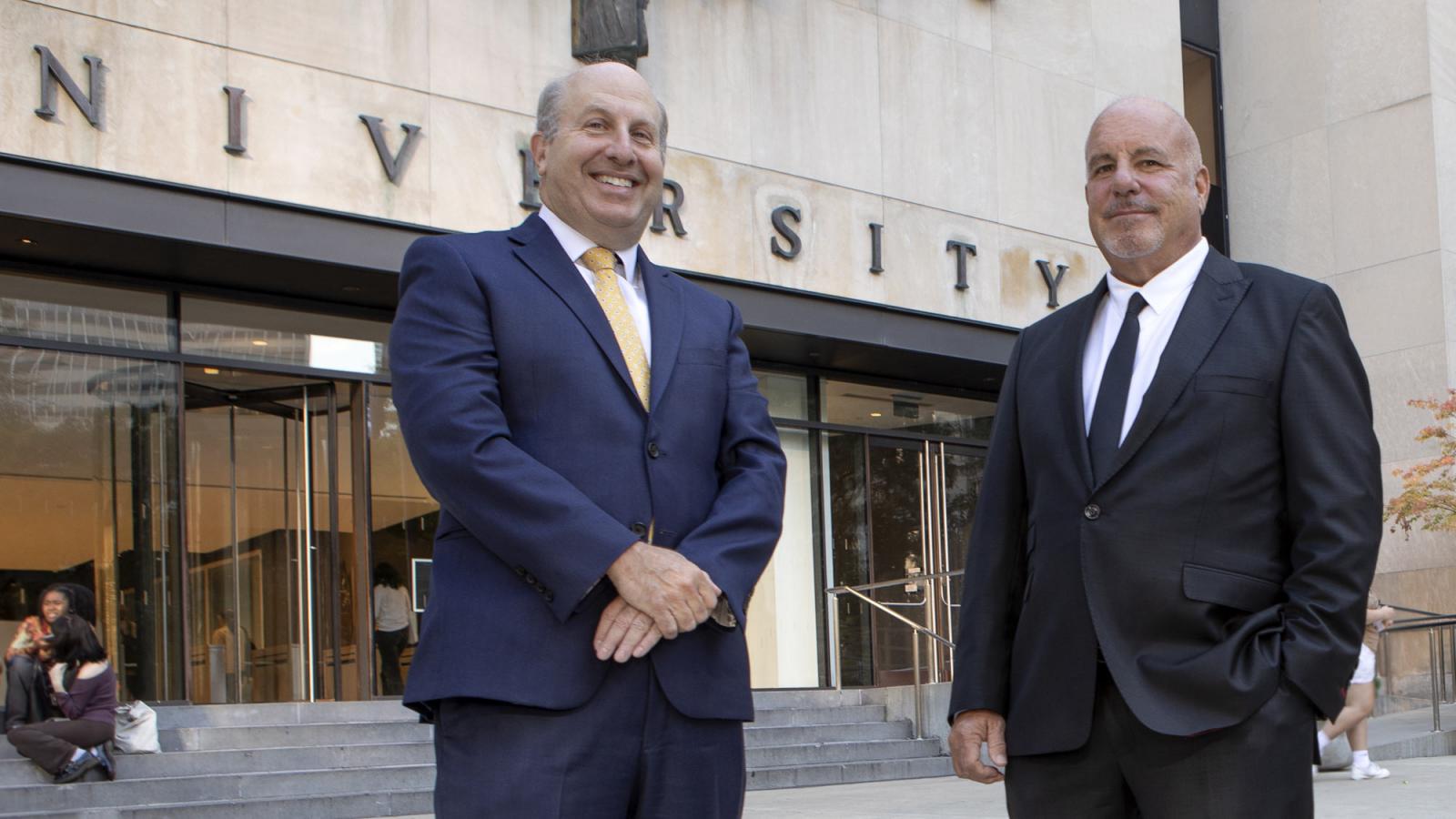
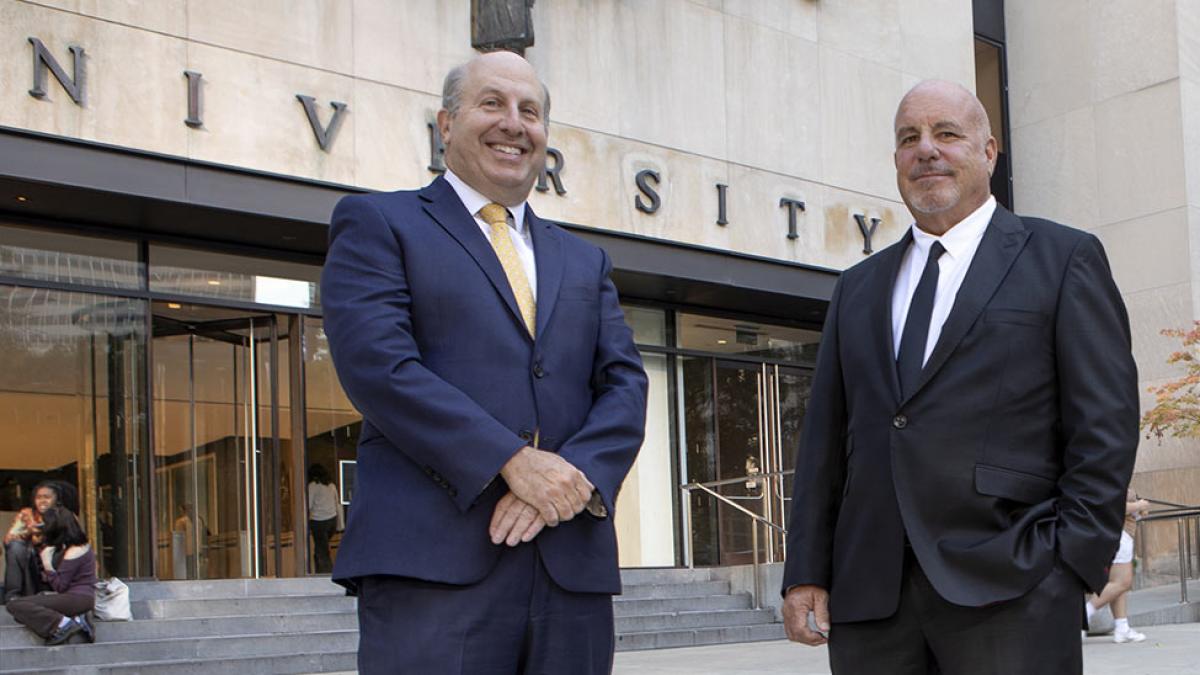
Welcome to the latest issue of Pace Magazine.
At Pace University, we are embracing innovation and adapting to the evolving needs of our community. As we navigate through this dynamic era, our commitment to providing immersive and challenging learning experiences remains steadfast. This issue is a testament to that commitment, showcasing stories of resilience, innovation, and ambition.
In this issue, you can find an exploration of the spectrum of experiential learning opportunities students can find at Pace—whether that’s in the field of water safety, business, dance, or social justice, our students are applying their learning beyond the classroom. Additionally, you'll be introduced to the inspiring work of professors Tim Myers, PhD, and Kimberly Stephens, PhD, and their new epilepsy lab in Pleasantville, where they blend personal experience with cutting-edge science. We also invite you to step into the historic Pace Study at 41 Park Row, a space that embodies the rich legacy and continued evolution of our university.
We are also pleased to showcase Seidenberg’s new BS in Game Development and a state-of-the-art Cyber Range expanding the depth of cyber education and preparing the next generation of cybersecurity experts. We highlight Pace’s burgeoning esports team, two First-Team All-American players on our field hockey team, and the unveiling of the Northwell Stadium, all of which mark exciting developments in Pace Athletics. We also focus our attention on the First Generation Program and the students it supports, a professor developing therapeutic board games for kids, and a $1.48 million grant from New York State to help reduce Pace’s carbon emissions.
As always, this edition of Pace Magazine is a celebration of our community's innovative spirit and relentless pursuit of excellence. Thank you for being a part of it.
With Pace pride,
Marvin Krislov
President
Rob Sands, JD ’84
Chair, Board of Trustees
More from Pace Magazine
Experiential learning isn't just a trend in higher education; it's the heartbeat of the Pace experience. From donning hip-waders to assess water quality, documenting first-hand narratives of a groundbreaking era in human history, immersing in a transformative semester in LA, to initiating and overseeing on-campus businesses from inception—Pace students don't just learn, they do.
Nestled in a corner of the 16th floor of the iconic 41 Park Row, a building steeped in history, the Pace Study is a hidden gem. Within its walls, the Study served as the workspace for Robert S. Pace, the second president of Pace University and son of co-founder Homer Pace. Nowadays, it's a haven for small, but significant University meetings.
When his wife Kimmi Stephens suddenly had a seizure, Tim Myers, a scientist studying epilepsy, felt his field of study abruptly collide with reality. This shocking moment sent the pair of Pace professors on a winding journey of recovery, resilience, and research, and ultimately to the creation of a new lab on the Pleasantville Campus.
Serving Up Success
For the Nutrition and Dietetics Department within Pace’s College of Health Professions, the expansion of teaching kitchens means committing to a culture of wellbeing while educating future Registered Dietitians.
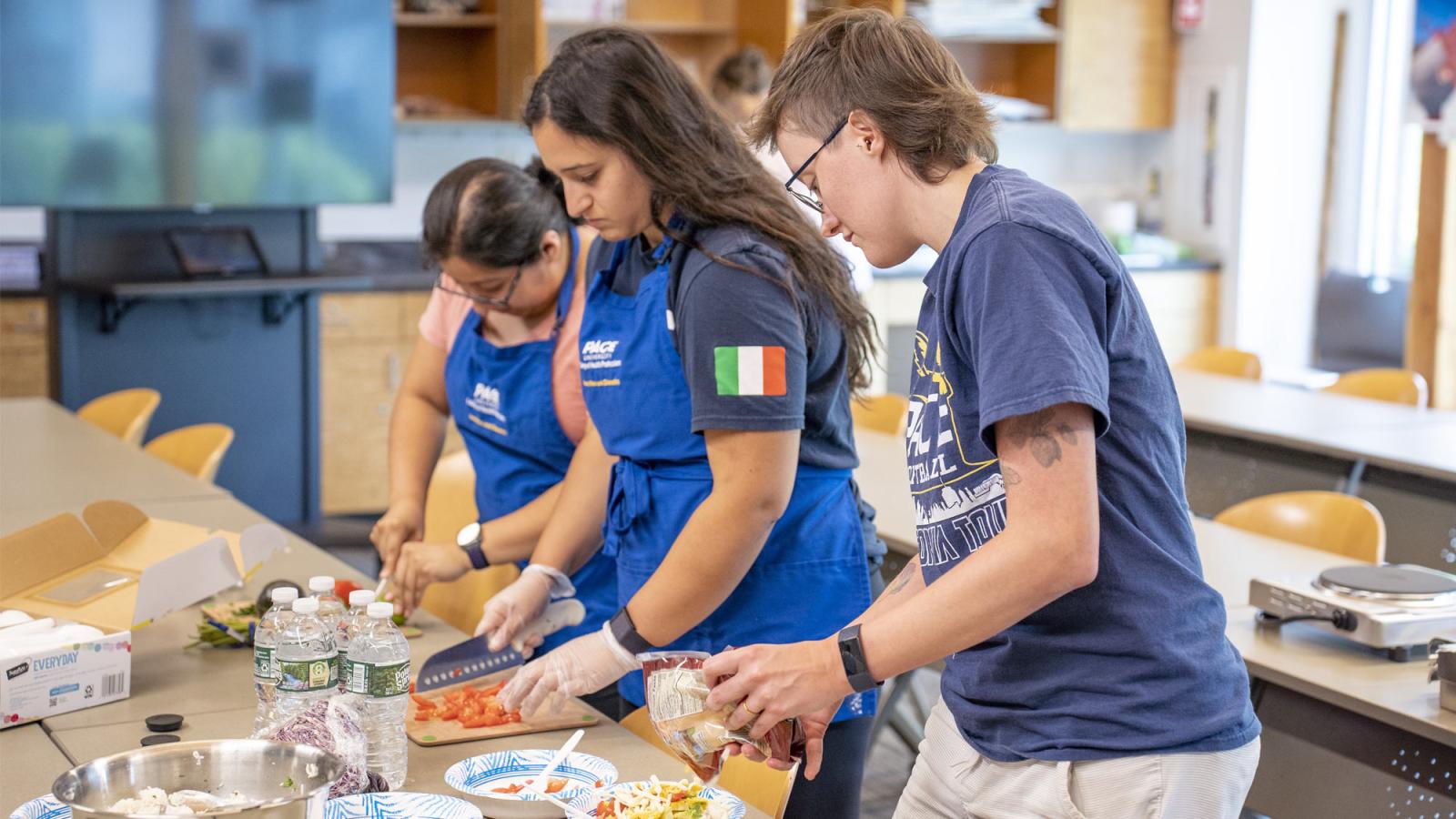
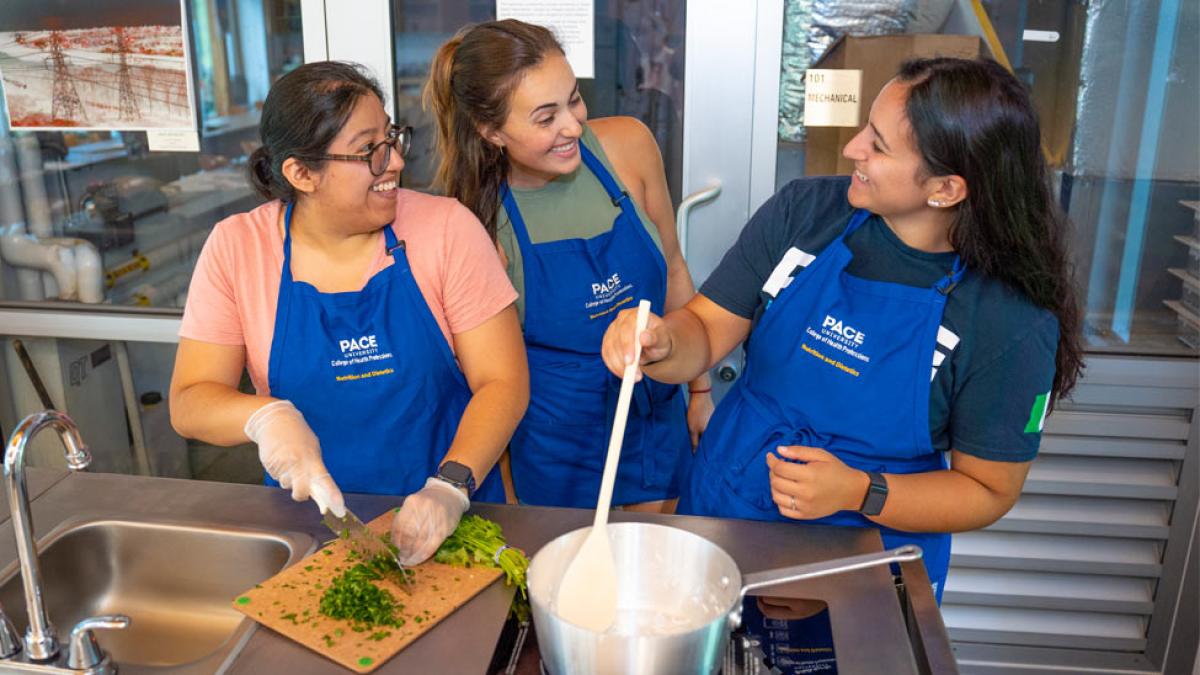
The freshest ingredients, the sizzle of pans, wafting aromas—not the first things that typically come to mind when you think of a classroom. At Pace, the seemingly disparate worlds of the art of cooking and the science of nourishment seamlessly converge, creating an educational experience that is as delectable as it is enlightening.
The Pace University Teaching Kitchen, housed within the College of Health Professions’ Nutrition and Dietetics Department, is not merely a place where recipes are followed, but a space dedicated to developing a culture of wellbeing and nourishing the community through culinary mastery.
The Pace University Teaching Kitchen is on a mission to redefine the narrative around culinary education and recently securing a mini-grant through Pace’s Center for Wellbeing was pivotal for the program.
“We’re using the grant to expand programs focused on cooking on a budget and the importance of eating meals together, while continuing our core focus of educating future registered dietitians on the importance of culinary nutrition and food as medicine,” explains Department Chair and Clinical Associate Professor in the Nutrition and Dietetics program Jessica Tosto, MS, RD, CDN, CSP, CNSC.
Over the past year, the Teaching Kitchen has undergone a remarkable transformation, spreading its influence far beyond the confines of the ZWILLING Cooking Studio, located off-campus in the town of Pleasantville, where students participate in hands-on learning activities. The team has recently added an on-campus mobile teaching kitchen, which has brought the magic of culinary education to members of the Pace Community, breaking down barriers and making good eating accessible. This year alone, the number of cooking activities on campus has tripled—with special sessions for Pace student-athletes, faculty, and staff.
But it doesn't stop there. The group was recently accepted as an organization member with the Teaching Kitchen Collaborative (TKC), a 501c3 global nonprofit dedicated to using teaching kitchen facilities as catalysts of enhanced personal and public health across medical, corporate, school, and community settings.
“We are thrilled to be accepted into the TKC as an organization member,” says Tosto. “Joining the TKC allows us to expand our network of innovative, like-minded colleagues, share resources, and collaborate on research and best practices in the field of culinary nutrition and achieve our mission.”
At Pace, our Teaching Kitchen isn’t just a place where food is prepared. Instead, consider it a sanctuary that embodies the ethos of wellbeing, community, and culinary artistry—a place where the mission is not just spoken but lived, one delicious dish at a time.
More from Pace Magazine
The Pace Field Hockey team had another successful year, in which not one, but two players were recognized as First Team All-Americans.
Meet Cyber Range: Pace’s new, state-of-the-art facility designed to give students a collaborative, practical immersion in tackling real-life cybersecurity threats, all in real-time.
Through a $1.48 million grant, Pace is providing a blueprint for large-scale energy-efficient projects.
Winter 2024: 10 Things to Inspire You
Pace clinched the title of Westchester's best. Our Broadway spotlight is shining. Carbon emissions? We're slashing them. We've introduced a new initiative for hidden disability awareness. Oh, and did we mention our sleek new building in NYC? All this and more in 10 Things to Inspire You!
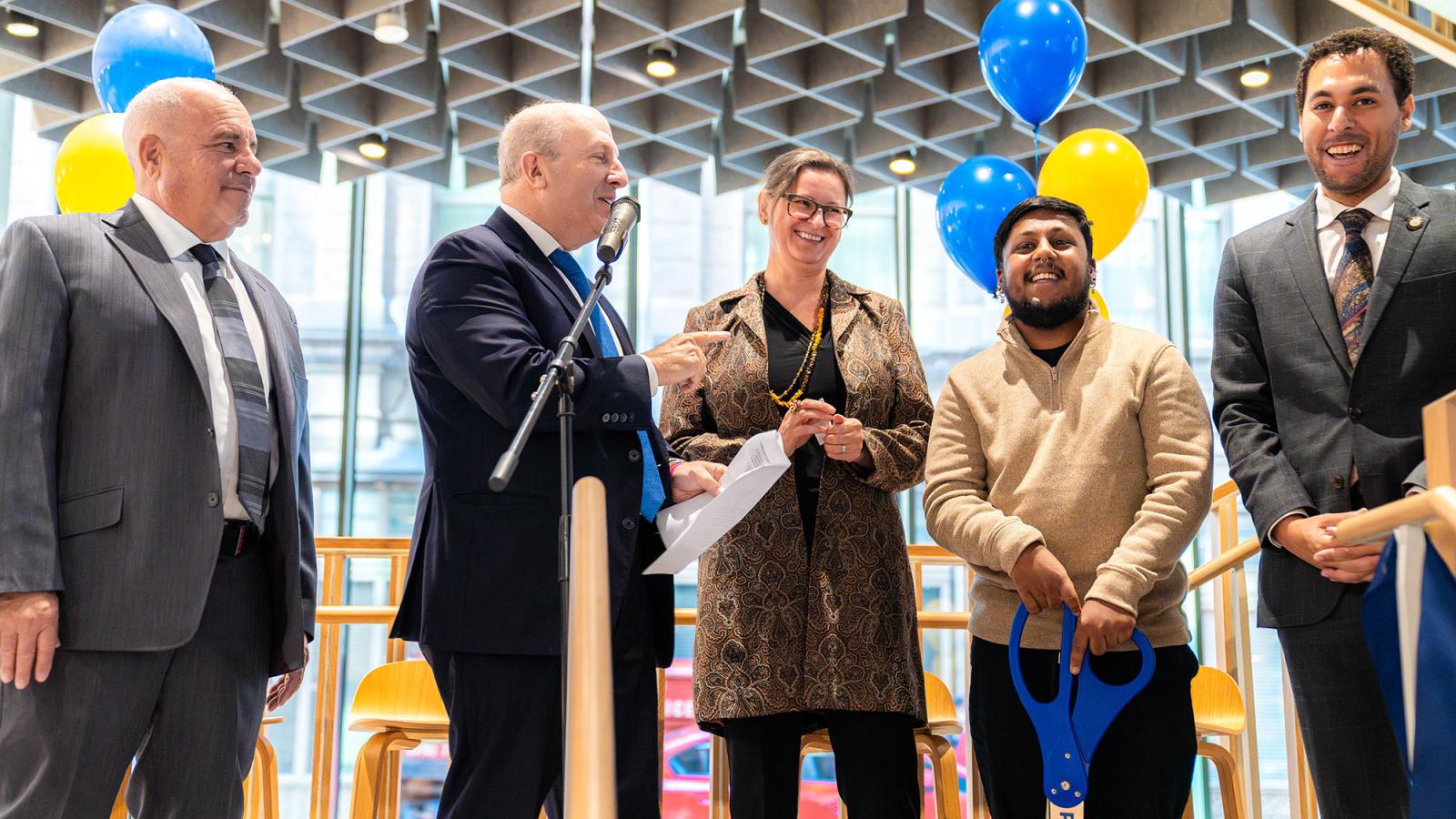
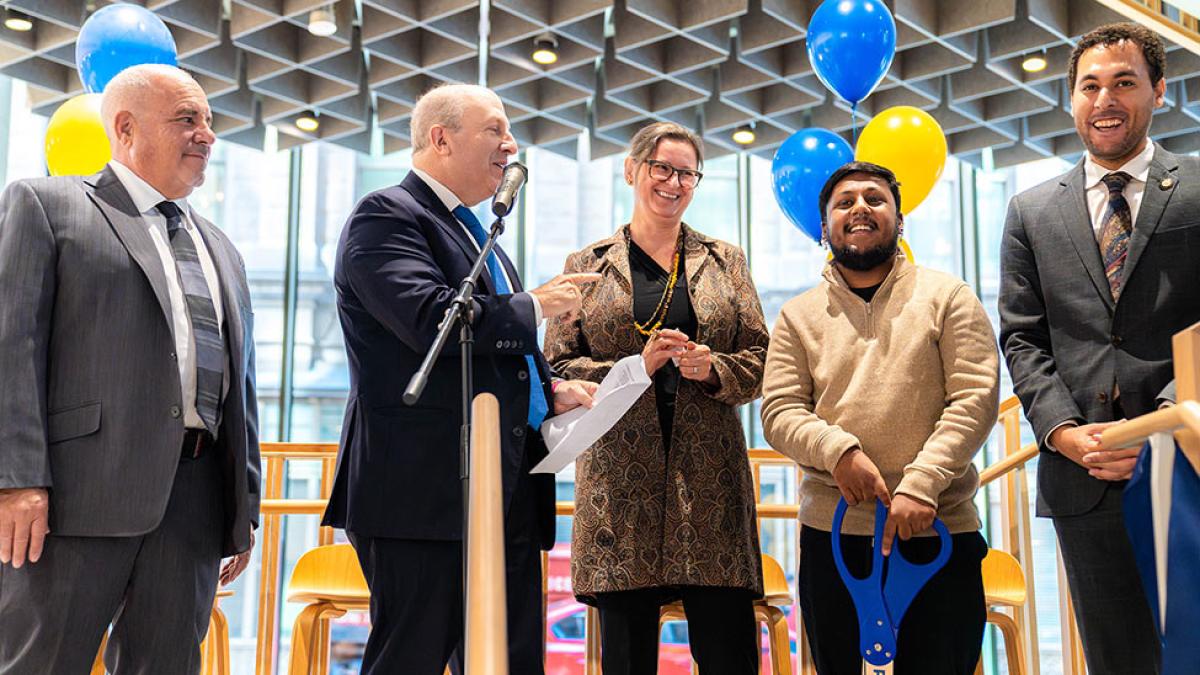
The Best in Westchester

Pace University was voted the best college/university as part of Westchester Magazine’s Best Of Westchester 2023 list. We’re hoping to keep the title in 2024, so keep your eyes peeled for information about how to vote.
Going Green(er)
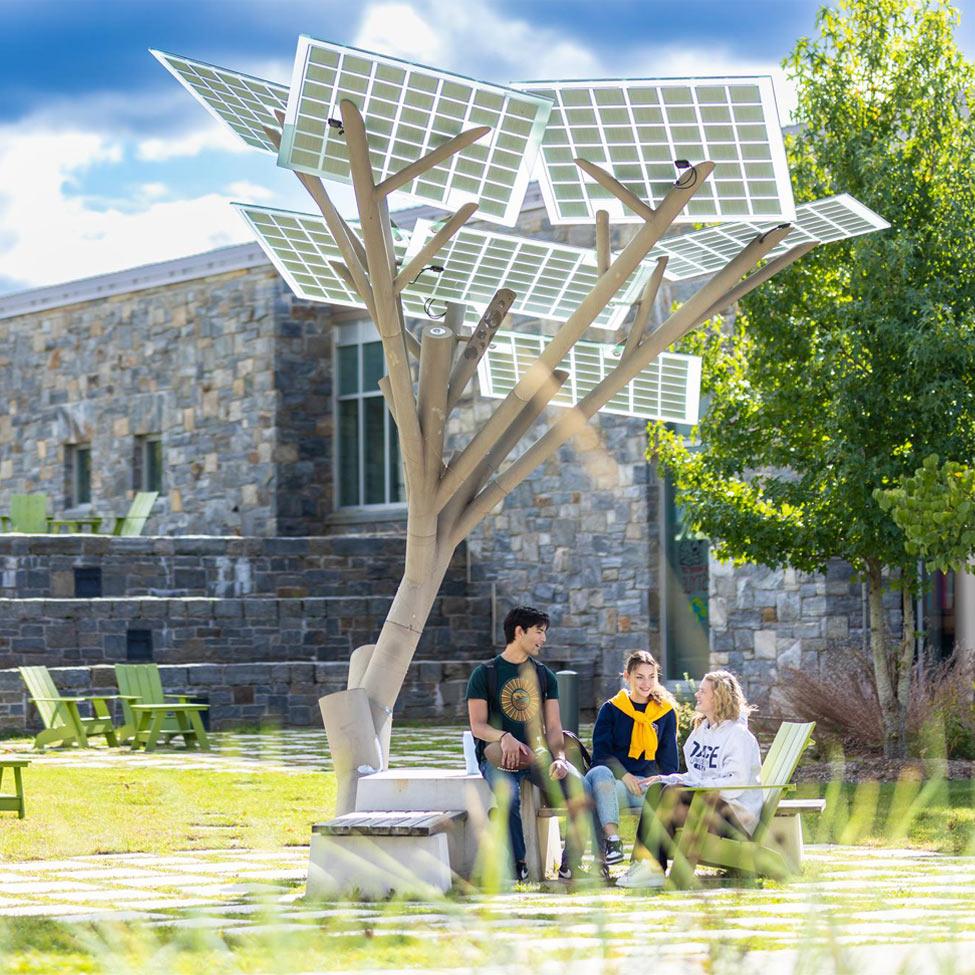
As a Better Climate Challenge partner, Pace implemented a coordinated energy management strategy, reducing our greenhouse gas emissions by nearly 25 percent, earning us a 2023 Better Practice Award! Did you know that we’ve demonstrated an active role in energy management since 1973? The University has implemented over 350 projects, aimed at conserving electricity, natural gas, steam, or water, resulting in several million dollars of total savings.
Most Representation on Broadway
Kimberly Akimbo. Moulin Rouge! The Musical. Hamilton. Beetlejuice. Dear Evan Hansen. Pace people clearly knows how to make it to the main stage. We’re once again on Playbill's Big 10 list of schools and colleges with the most representation on Broadway in the last season. Nearly 35 Sands College students and alumni performed on a Broadway stage during the 2022–2023 season.
Breaking Records in Trial Advocacy
Haub Law’s team for the National Trial League Competition broke a record this year as they were the only school to ever remain undefeated in the National Trial League’s regular season, with a solid finish of seven wins and zero losses.
Dancing with Doja Cat
More than 865,000 people tuned in to MTV’s Video Music Awards this past fall. In addition to seeing a

wild amount of celebrities and A-listers, viewers also got the opportunity to watch as twelve Pace students and recent graduates of the BFA in Commercial Dance program took the stage alongside powerhouse performers like Doja Cat, Shakira, Olivia Rodrigo, and Karol G. We spoke with Joanne Daquigan '22, Jada Clark '22, and Tiffani Russell '23 who performed with Doja Cat alongside her Pace peers Aaliyah Zolina, Gabby Rembert, and Jada Ballard. Read about their experiences on stage at the VMAs.
It’s Official: 15 Beekman is Open!
With a lobby full of excited students, faculty, staff, and community members, Pace University cut the ribbon to celebrate the official opening of its brand-new building at 15 Beekman on October 11. The new building is a 26-story mixed use vertical learning hub that represents the next step in the years-long investment that Pace is making in its lower Manhattan campus. At the corner of Beekman and Nassau streets, the building features a residence hall housing nearly 500 students, dining facilities, a state-of-the-art library and learning center, tech-enabled classrooms, and three floors that constitute a dedicated home for the Seidenberg School of Computer Science and Information Systems.
The Best for Vets
Pace University has once again received recognition for its exceptional support for military service members and veterans. In the latest rankings of Best for Vets: Colleges by Military Times, Pace secured the third spot among 29 state-wide institutions, ranking ninth among private colleges nationwide and 66th overall. “Student veterans have a holistic view of the importance of their education,” said Neath Williams ‘24. “Most have goals set for after school, and they’re focused on that. They may be more focused on learning the actual content rather than on passing the class. This is the stuff we came here for, and Pace provides the resources for us to be successful.”
Flower Power
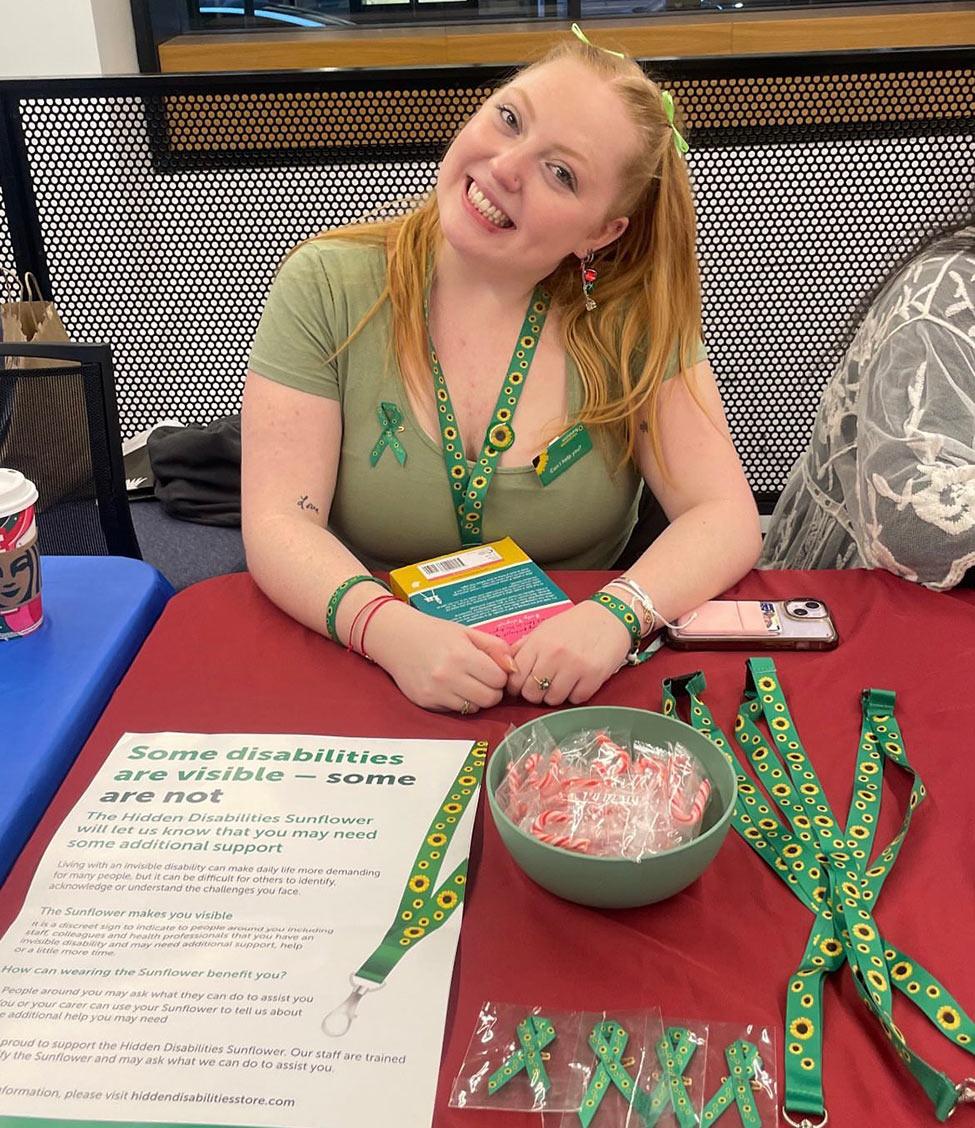
Pace student and UN Millennium Fellow Lucie Belle Flagg ’24 channeled both her frustrations and her energy into bringing greater awareness of hidden disabilities to the Pace Community. Through her tireless efforts, Pace University has become the first university in New York to officially launch Hidden Disabilities Sunflower program, empowering those with hidden disabilities to take up the sunflower icon as a means of representation and self-advocacy. “Anyone that self-identifies as having a hidden disability should consider getting involved by representing the sunflower on campus and educating their peers about hidden disabilities,” Lucie says.
Inclusive Theater
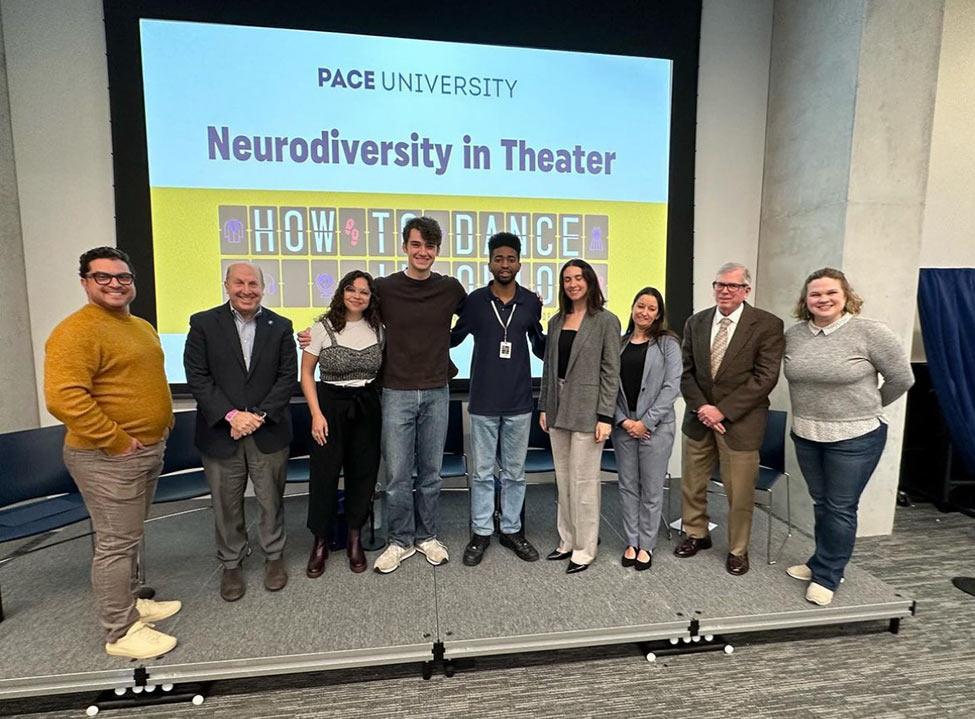
Our Neurodiversity in Theater panel brought Broadway's How to Dance in Ohio cast members including Hunter Hollingsworth and Sands College alumnus Liam Pearce '22 to campus to explore the power of inclusion and representation with Seidenberg’s James Lawler, DPS, and School of Education’s Jennifer Pankowski, EdD. The conversation about autism, disability, and inclusion in theater was moderated by Jesse Carlo and Amanda Grace Flynn of the Sands College of Performing Arts.
A New Name for CHP’s Simulation Labs
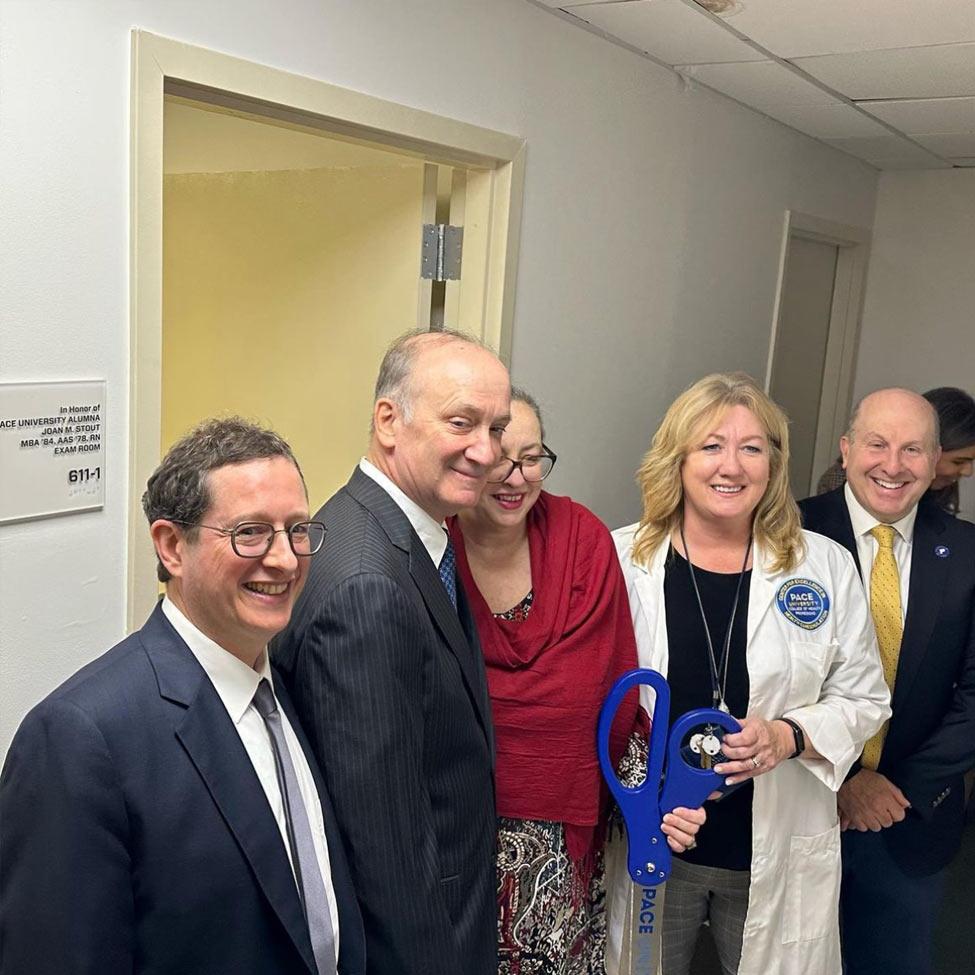
Pace University dedicated the simulation lab on the NYC Campus in honor of the Stout Family and the Hugoton Foundation. With more than 20,000 hours of simulation conducted per year at Pace, the design of the Simulation Labs is to replicate various healthcare settings, including pediatrics, maternity, and medical-surgical and critical care units providing the students an opportunity to practice skills at basic and advanced levels across the curriculum.
More from Pace Magazine
Pace's new BS in Game Development is a game-changer, literally. Created by Seidenberg’s resident ‘game guy’ Carmine Guida, the program combines technological foundations with hands-on practice to prepare students to thrive in one of the fastest-growing industries worldwide.
Through a $1.48 million grant, Pace is providing a blueprint for large-scale energy-efficient projects.
As part of a partnership between Northwell Health and Pace Athletics, team members will receive world class care through an exclusive partnership with Northwell; and play under the lights at Northwell Stadium.
When Research Gets Personal: Meet Pace’s Epilepsy Advocates
When his wife Kimmi Stephens suddenly had a seizure, Tim Myers, a scientist studying epilepsy, felt his field of study abruptly collide with reality. This shocking moment sent the pair of Pace professors on a winding journey of recovery, resilience, and research, and ultimately to the creation of a new lab on the Pleasantville Campus.


It was 2018. Married couple Timothy Myers, PhD, and Kimberly “Kimmi” Stephens, PhD, were settling into their seats at a movie theater to watch The Incredibles 2 for Tim’s birthday.
They didn’t finish the film. During the title sequence, Kimmi had a seizure. She had never had one before, but as a computational and cellular/molecular neuroscientist specializing in an area called network hyperexcitability, he recognized the signs immediately.
He knew it was a seizure, but he didn’t know what to do.
Kimmi’s seizure not only marked a significant shift in their personal lives, but also in the trajectory of their careers, bridging the gap between Tim’s theoretical studies with the stark reality of what it’s like to live with epilepsy.
Tim and Kimmi
Kimmi and Tim met in 2014 at UC Riverside, when Kimmi invited Tim to a Thanksgiving potluck with the Biology Department. Tim was pursuing his PhD in neuroscience, and Kimmi her PhD in entomology. A year later, in December 2015, they married.
Kimmi’s academic expertise is vast, encompassing a wide range of fields including vector biology, host pathogen interactions, reproductive physiology, and circadian rhythms. Her passion for research provided her with an extensive background in protein biochemistry and molecular genetics. She finished her PhD in 2016 while Tim continued work on his degree.
It was kind of ironic that I was a specialist in the field by the time 2018 came along. —Tim Myers
Since 2014, Tim’s research narrowed in on understanding seizure disorders and the process by which the brain develops epilepsy. “I specifically look at the cellular and molecular mechanisms of epilepsy, so trying to figure out what makes certain types of epilepsy start,” Tim explains. “It was kind of ironic that I was a specialist in the field by the time 2018 came along.”
Neither of them knew how much his research would eventually intertwine with their personal experiences.
The Accident
Six months before that day in the movie theater, Kimmi was in an accident where she was struck by a raised Ford F-150. “The car was going about 50 miles per hour, and she flew and hit her head on the asphalt about 40 feet from where she was struck,” Tim recounts. Her survival probability was estimated at 20 percent. Her physical injuries included a compression fracture of her upper cervical vertebra, multiple lacerations, contusions, concussion, loss of consciousness, and severe traumatic brain injury.
The timing couldn’t have been worse. “While Kimmi was in the ambulance leaving the scene, she got a call from our escrow agent saying we closed on our house in Southern California,” Tim said, thrusting the couple into severe financial strain.
But it wasn’t just financial pain, but deep, physical pain that plagued Kimmi. “She has two types of neuropathies, which involves damage to peripheral nerves.” Tim explains. “One is occipital neuralgia, and the other is something called trigeminal neuralgia.” Additionally, Kimmi developed postural orthostatic tachycardia syndrome (POTS) a condition where standing up causes an unusually large increase in heart rate, leading to symptoms including: dizziness, fatigue, loss of muscle tonicity and, in her case, syncope—loss of consciousness.
So profound is the pain caused by this type of nerve damage that it has earned an ominous name. “It’s not a diagnostic name,” Tim says. “But trigeminal neuralgia is called ‘the suicide disease’ because a significant number of people who develop this pain attempt to commit suicide … and Kimmi has both trigeminal AND occipital neuralgia.” Even the American Association of Neurological Surgeons indicates that trigeminal neuralgia is “sometimes described as the most excruciating pain known to humanity.”
This pain went untreated for years.
For years Kimmi dealt with this excruciating pain. —Tim
While there is some relief for the occipital neuralgia via monthly injections directly into the damaged nerve, there is very little that can be done for trigeminal neuralgia aside from invasive surgery. “For the longest time, nobody would give her any medication or help with any therapeutic efforts (with respect to pain management and the seizures) because they just thought she was faking it,” Tim recounts. “For years Kimmi dealt with this excruciating pain. I wasn't even aware of how bad it was because she was so good at hiding it. And she would just walk through life smiling, having conversations with people.”
And then six months later, she had her first seizure in that movie theater. Her form of occipital epilepsy can be challenging to detect and diagnose correctly through conventional electroencephalography—the gold standard of epilepsy diagnosis. Following her epilepsy diagnosis, Kimmi started the next new (and somewhat ironic) chapter in her life post-injury.
The Unbreakable Kimmi Stephens
“I'm going to share something that I know Kimmi hates,” Tim says. “Kimmi is a genius. In third grade, she tested into college level English and math.”
Tim recounts how Kimmi not only turned down an invitation from Mensa, the world’s oldest high-IQ society, but also a full ride to the University of Oxford. Tim marveled at her ability to remember huge amounts of information with ease. “If she had to go grocery shopping for a hundred items, she didn’t even bring a list.” He’d be amazed when they returned home and not a single item had been forgotten.
Then came the car accident, and then the seizure that completely transformed Kimmi’s life.
It had gotten to the point where I basically wasn't doing anything on my own, because of the fear of a seizure. —Kimmi Stephens
She and Tim jokingly recount her hesitation about getting married because she had always been fiercely independent and feared losing any sense of her autonomy. Not only was she set back by the pain and process of healing from a traumatic brain injury, but the epilepsy diagnosis usurped her independent spirit with fear and anxiety.
“It was actually pretty bad,” Kimmi admits. “Because it had gotten to the point where I basically wasn't doing anything on my own, because of the fear of a seizure. If I'm cooking and I have seizure, I’ll get burnt, or pass out and have a severe injury. I was terrified to be on my own. And it's not a healthy dynamic, because I have to be able to do stuff on my own. For me, it's been really hard, not just accepting help, but the fact that I require the help at some points.”
A New World
But life needed to continue. Kimmi was finally prescribed the proper dosage of her antiepileptic medication in early 2019 which facilitated the healing process.
Kimmi came out of a brain fog in mid-2019, Tim insisted that Kimmi find a fulfilling job that she wanted to do, anything, anywhere. He told her, “We'll drop everything in California, I don't care where it is. We'll just start over.”
Kimmi accepted a postdoctoral research position at Mount Sinai School of Medicine focused on developing a treatment for genetic disorders. And so, they packed their bags and moved across the country. Kimmi moved to New York City in early January 2020, where she hoped to reclaim some of the independence she had lost. The couple agreed she’d go alone at first in the hopes that she could establish herself and foster her independence for a few months in the city. However, neither of them could anticipate the outset of the COVID-19 pandemic just a month later. The shutdown kept them apart for nearly a year, leaving Kimmi to navigate all of her disabilities, a new city, work as essential personnel at a major NYC hospital in the middle of a pandemic, and life without accessible familial support.
I have all this knowledge, but I didn't know what to do.—Tim
When Tim finally arrived in NYC, he took a part-time job teaching neuroscience at Columbia University. It was in this role that he decided to inject epilepsy awareness into his classes, because even with his background there was so much for him to learn.
“When Kimmi had her first seizure, I recognized it for what it was, but I had no idea what to do,” he says. “It was the most frightening and humbling experience of my life. I have all this knowledge, but I didn't know what to do.”
Tim finished his PhD in 2021 after leaving his graduate program in 2018 to care for Kimmi and work multiple jobs for better insurance and financial security. “I'm really, really proud of him for finishing his PhD,” Kimmi says. “It was sort of traumatic, because his PhD research was on epilepsy, and then I developed epilepsy. Then he had to go back and look at the research and there's trauma there.”
In the Classroom
Tim’s teaching began to focus not just on understanding the neuroscience behind brain pathologies, but the real world impact for people living with it.
“I realized that my teaching was very static. I'm going to teach you about all this neuroscience, about Alzheimer's, about epilepsy,” Tim says. “But there was no humanistic component to it, which was not something I cared about in the past. But all of a sudden, I realized there is so much value there.”
He and Kimmi formed a relationship with Epilepsy Foundation of Metropolitan New York (EFMNY), whose parent company provides online seizure first-aid and recognition training. When he began teaching neurobiology at Pace during the Spring 2022 semester, he brought this work with him, and now all of his Pace students get certified in seizure recognition and first aid as part of their coursework.
I talk about the mechanisms, what's going on inside the human brain, and then she talks about what it's like to live with these conditions.—Tim
Tim continued to stay mindful of how the impact of his work affected Kimmi. “There’s a fine line in my brain between exploiting Kimmi’s condition and teaching people about her condition,” he explains. So, it seemed a natural progression when Tim asked Kimmi to come and speak to his students in her own words, and she began sharing her experiences with his Pace and Columbia students. Tim thought it would not only be beneficial for his students to get exposure to someone impacted by the issues they were studying in the classroom, but hopefully provide some catharsis for Kimmi.
“I'm not going speak for Kimmi about how it affected her, but personally I've seen her able to open up more and more,” he says. “And the students, particularly the female students, seem to have really positive feedback, because Kimmi doesn't only talk about her experiences with epilepsy, but her wider experiences as a female scientist.”
Tim thinks this personal element is key to teaching their students. “I talk about the mechanisms, what's going on inside the human brain, and then she talks about what it's like to live with these conditions. And I think that's probably one of the most powerful things that we've done for the students.”
In the Lab
Tim and Kimmi’s work is not just confined to the classroom, though. After completing her post-doctorate, Kimmi came to work at Pace as an adjunct professor beginning the 2023 fall semester. In early 2023, Kimmi officially joined the lab on Pace’s Pleasantville Campus to further develop a comprehensive, and much-needed seizure and traumatic brain injury research program with Kimmi supplying her background on molecular biology and Tim bringing his experience as an electrophysiologist and computational neuroscientist.
Their initial research goal is to examine proteins in the brain linked to the neuroinflammatory response following traumatic brain injury to determine how that might induce seizure activity.
“We jointly decided to take this direction, to conduct research in the area of Kimmi's pathology,” Tim explains. “We hope to increase understanding of epilepsy and potentially contribute to future pharmaceutical interventions.”
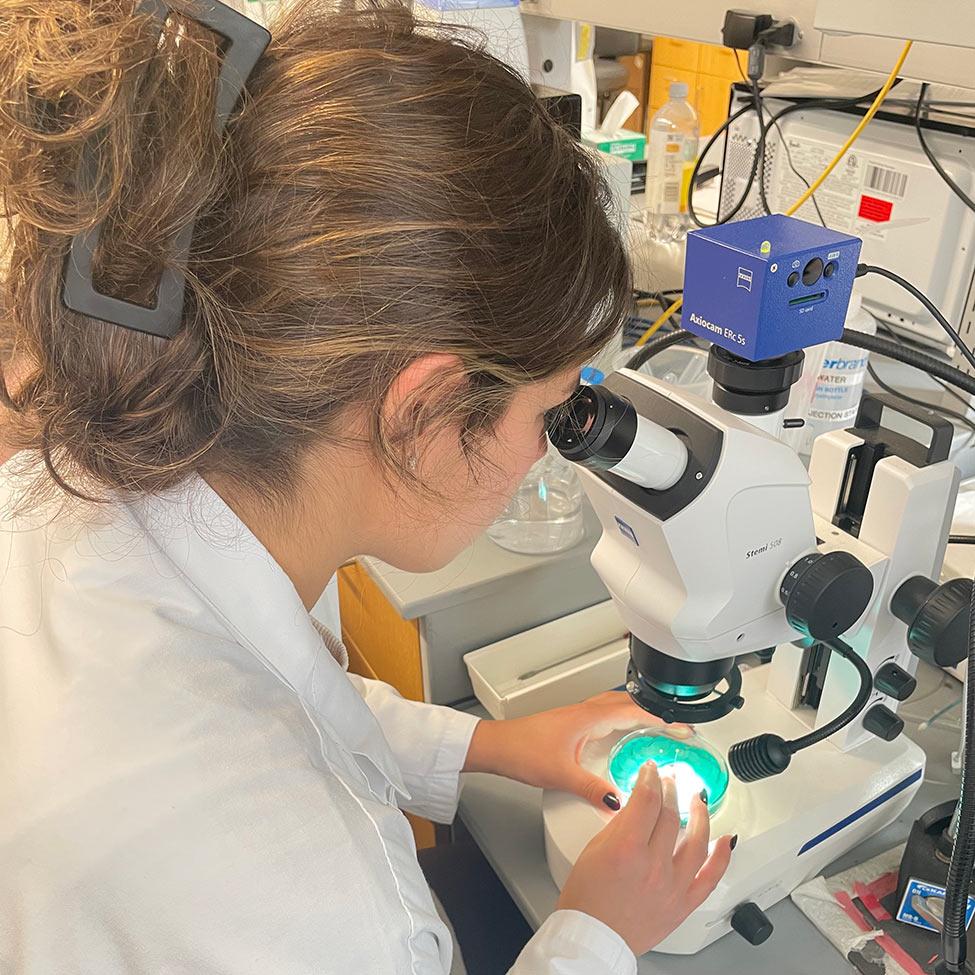
Their students have the opportunity to collaboratively explore this epilepsy research. “We currently have three Pace students that have joined the lab this year,” Tim says. Tim developed a computational model of specific proteins and cell interactions within the traumatized brain. In the lab, the students (alongside Tim and Kimmi) will be able to interact and assist in the development of this model, simulating changes in these proteins to observe ‘seizure’ activity within the in silico (computer simulated) environment.
There is also some research equipment at Pleasantville that you wouldn't necessarily find at a smaller university.—Tim
They hope to soon receive approval to expand the lab’s research into the ‘wet lab’ (experiments that use a physical specimen) in which they can study seizure activity in zebrafish. Aaron Steiner, PhD, manages the zebrafish facility on the Pleasantville Campus and utilizes these animals in his research. “Aaron’s expertise, advice and mentorship with respect to fish research has been invaluable,” says Tim. “There is also some research equipment at Pleasantville that you wouldn't necessarily find at a smaller university.”
Their plan is to try to secure more funding, working with organizations such as the National Institute of Neurological Disorders and Stroke (NINDS) and the Epilepsy Research Program (ERP) through the Department of Defense. Aside from reagent and general lab expenses, their hope for this funding is to compensate Kimmi for her lab work (which she currently conducts on a volunteer basis) and to expand the scope of their research into the hereditary nature of hyperexcitability and explore the delay between a TBI and the manifestation of epilepsy—projects which would necessitate the use of zebrafish. They also hope to be able to continue their advocacy efforts and bring epilepsy awareness to a larger audience.
These students have never had a person sort of open up to them like that—Tim
They both express the joy they have at not only finding a home for their lab at Pace—where state-of-the-art lab facilities and collaboration across disciplines has enabled further research—but in the opportunity to mentor these students, from offering their insights into navigating the science field, writing recommendations, and even assisting with PhD applications.
Kimmi has found that she especially has an impact on female students. “I think this is because she talks about what it’s like to be a female scientist, and shares harassment that she’s experienced,” Tim suggests. “These students have never had a person sort of open up to them like that, and just be willing to talk about things that are often considered taboo.”
Teaching the Human Impact
Neither Tim nor Kimmi anticipated how much their life would change after Kimmi’s accident. Their research in the lab and advocacy in the classroom was not something they set out to do but was a natural progression of their work adapting to new challenges. According to Tim, “We were just kind of doing what we think is right. It's what we have to do for our own sanity.”
What they’ve discovered is that while they’re doing work within their fields, they are now equipped to bring something to their science students that is so often missed: the human element.
Kimmi explains, “A lot of our students want to study these conditions or be in the medical profession. I think knowing or interacting with someone with this condition in a less professional situation allows them to actually see the human behind it. In which case, when they go in, they start doing work in these fields, they have a little more compassion for the people that they're treating.”
I think knowing or interacting with someone with this condition in a less professional situation allows them to actually see the human behind it.—Kimmi
Some of their students even experienced the harsh reality Tim had to face that day in the movie theater on a day where Kimmi came to speak as a guest. As she was answering a student question about what she remembered from her accident, she had an absence seizure, which involves a sudden and often brief lapse of consciousness. “It literally happened while she was talking upfront, and everybody got concerned,” Tim recounts. But he was able to remind his students, “I said, ‘Look, you guys are trained in epilepsy recognition and first aid. You’re okay.’”
When Kimmi came to, it was a powerful moment for the students as she reassured them that she chose to come in and speak, and that this is part of her disability. Kimmi admits she has some anxiety about speaking in front of people, and she has the added worry that she could have a seizure at any point. But as both Tim and Kimmi pointed out, the lack of awareness has created stigmas around disabilities, and about what people with disabilities are capable of. Especially, as Kimmi points out, in the sciences.
“Science, in particular, can be a little bit toxic,” she says. “They push people to be super productive to the point that a lot of people don't really get a chance to relax or take care of themselves.” For her, she has the added worry that her epilepsy and POTS might cause people to doubt her abilities.
I think it's really important that they see and hear the human aspect of it.—Kimmi
But Kimmi, despite her anxiety, and despite her seizure, continued to speak to the class, offering a once-in-a-lifetime insight to students who may one day be on the forefront of epilepsy research. “It’s all about awareness,” Tim says. “People with these conditions can absolutely do amazing things.”
Kimmi agrees, saying, “And I think it's really important that they see and hear the human aspect of it.”
From their budding research into the science of epilepsy, to their integration of their personal experiences in the classroom for a new generation of scientists, and to their deep dedication to advocacy for people with disabilities—Tim and Kimmi’s journey embodies a relentless pursuit for a better world.
At the heart of their story is a powerful message: the true impact of science and education lies in its ability to transform lives, not just in theory, but in the tangible, everyday world.
If you are interested in learning more or getting involved in Tim and Kimmi’s research, reach out to tmyers@pace.edu and/or kstephens2@pace.edu.
More from Pace Magazine
Nestled in a corner of the 16th floor of the iconic 41 Park Row, a building steeped in history, the Pace Study is a hidden gem. Within its walls, the Study served as the workspace for Robert S. Pace, the second president of Pace University and son of co-founder Homer Pace. Nowadays, it's a haven for small, but significant University meetings.
Through a grant from the New York State Department of education, School of Education Professor Jennifer Pankowski is helping students with disabilities to thrive at Pace and beyond.
Through a $1.48 million grant, Pace is providing a blueprint for large-scale energy-efficient projects.
Building Legacies with Pace's First Generation Program
Pace’s First Generation Program is dedicated to uplifting and supporting first-gen students who are often left to chart their own course. Read on for student perspectives on the unique challenges and experiences these students face.
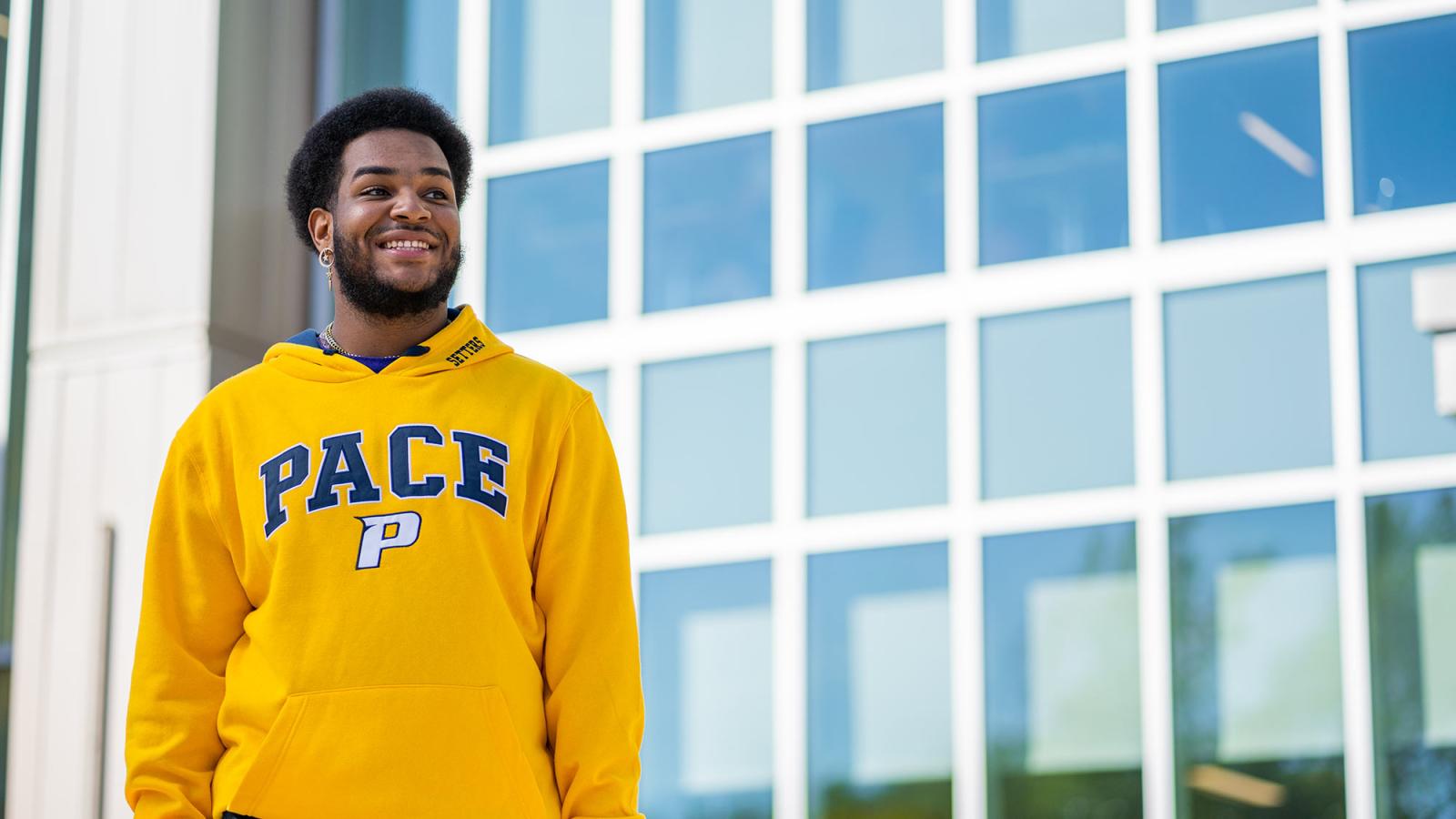
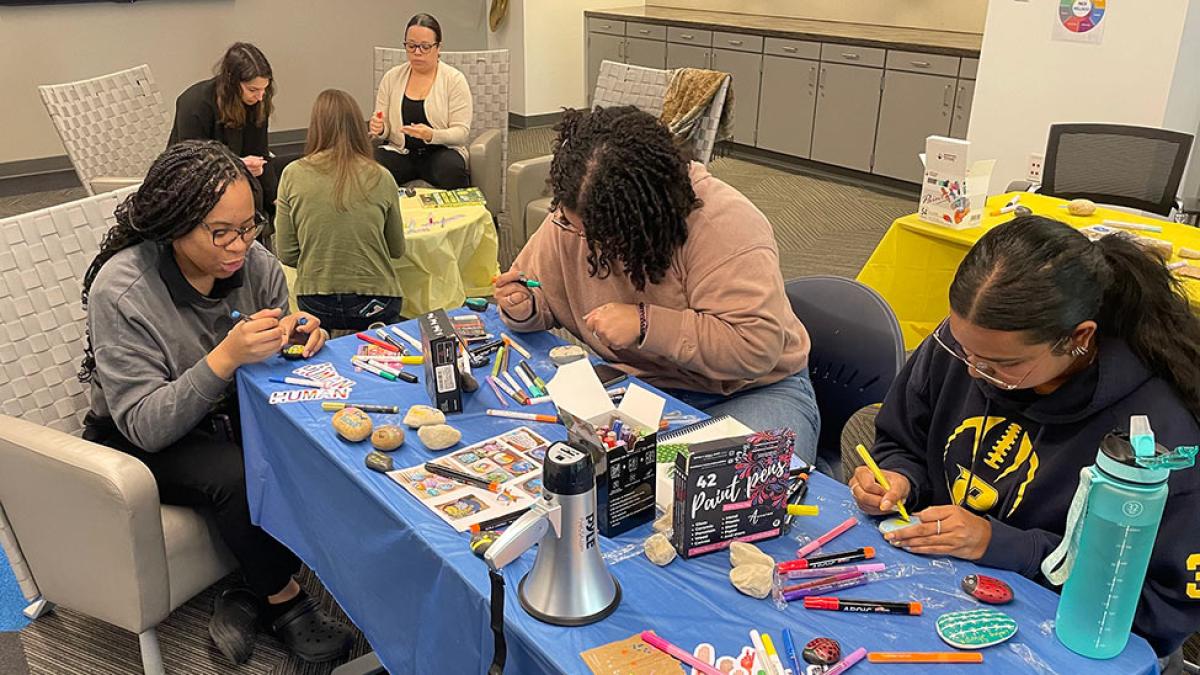
Being a trailblazer isn’t easy. Nevertheless, every year, first generation students take up this mantle as they bravely begin their educational journey, making a new path for themselves. It’s a daunting challenge, but Pace’s First Generation Program is dedicated to supporting these students, making sure they don’t have to go it alone.
But, before we go on, we have to answer a really important question: what is a first generation student? A person can consider themselves a first generation student when neither of their parents (this includes step-parents and legal guardians) have completed a bachelor’s degree OR if they earned a degree outside of the US. According to Valentine Rojas Abreu ’24, “Some people don’t even realize they’re a first generation student.”
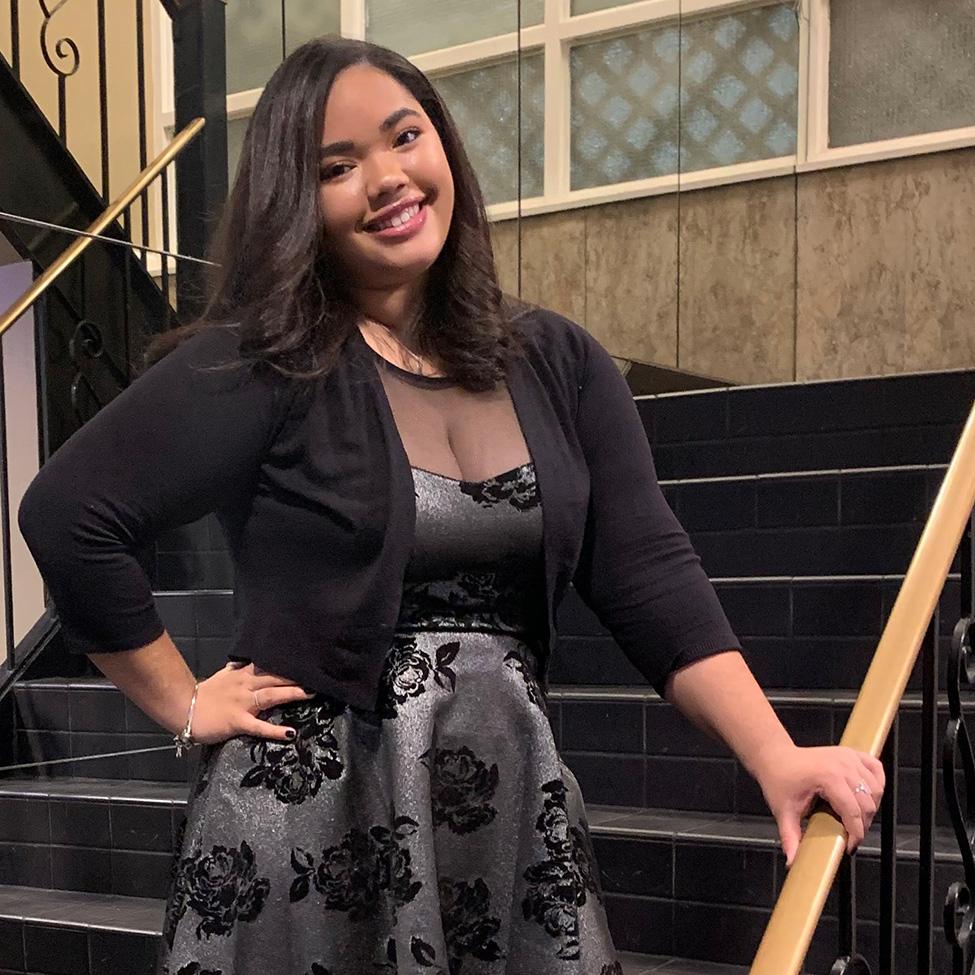
Valentina knows this better than most, as she has a deep connection to the first generation program at Pace, and the people it serves. As a first-gen student herself, she participated in the program as a mentee during her first year at Pace, before becoming a mentor herself. Now she’s the president of the program, offering new students the same support she found when she first started.
Many first generation students share similar feelings on the unique challenges they face navigating college. “My family members don’t always understand the stories I tell them about my college experience,” says Amber Brouwer '24. Danielle Shoulders ’24 has felt this too, saying, “I’m not able to ask about the college experience from my parents. I have overcome this by making my own support system.”
Having to figure things out on your own can help students reach for the stars.—Valentine Rojas Abreu
That’s where the First Generation Program can help, and both Amber and Danielle agree that building a community of other first-gen students helped ease some of the growing pains. According to Amber, “They understand the struggles you’re going through and remind you that you aren’t alone.”
The program also connects students with tools that help them in the transition into college. “Pace has a wide range of resources and events that college students can attend to learn more about the ins-and-outs of college,” says Danielle. D’Andre Butler ’25 says the program has done wonders to help him build connections. “Networking has been the best part of my experience,” he says. “Since my first year I have grown so much by creating opportunities for myself and making connections with pretty important people.”
I saw these four years as the time for me to try every club, job, and opportunity that I found interesting. —Amber Brouwer
Some first generation students believe that their unique challenges strengthen their resolve and even benefit them in the long run. “Yes, things were harder at first, because figuring out all of the right paperwork and financial aid on your own can be hard,” Amber admits. “But I also wanted to take every opportunity I had. I saw these four years as the time for me to try every club, job, and opportunity that I found interesting.”
This thirst for more is something Valentina sees in many of the students in the program, and she believes this spirit of independence ultimately encourages success. “Having to figure things out on your own can help students reach for the stars,” says Valentina. “They have to find opportunities and have higher aspirations because they know they’ve always had to.”
With the help of Pace’s First Generation Program, these students are not just navigating uncharted waters but transforming their challenges into assets as they begin to build their own legacies.
To learn more about Resources for First Generation Students, visit the First Generation Program site
More from Pace Magazine
Through a grant from the New York State Department of education, School of Education Professor Jennifer Pankowski is helping students with disabilities to thrive at Pace and beyond.
Pace Esports isn’t here to just play games–they’re setting records, championing inclusivity, and leading the charge in collegiate competitive gaming. (And yes, playing plenty of games along the way.)
Through Show and Spell, a captivating game designed to enhance social and emotional learning in children, Pace's Stan Royzman, PsyD, is helping children in a way that is simultaneously engaging and seeks to bolster positive therapeutic outcomes.
